Indochina, General Colonial Issues; French colonial ambitions already started in the 16th Century and she established colonies in the United States, the Caribbean and India but lost most of these conquests after the Seven Years War, a global war that was fought between 1756 and 1763. The country returned to colonial aspirations in the middle of the 19th Century after other European nations, namely Germany, had done the same to enhance their empire, but this time the country focused primarily on Africa and Indochina. Colonialism was driven primarily in the search of raw materials but also by the hope to acquire more manpower for potential future wars. It was based on the racist world view that the French were a superior race and that it was upon her to “civilize” what they considered inferior races.
The first official incursions into what is now known as Indochina were in the middle of the 19th Century when the country sent an expeditionary force into present day China in order to punish the country for the murder of a French missionary and the arrest of a French ship crew. This eventually led to the fact that China had to grant the United States and several European nations open ports in a number of Chinese cities but also allow the future importation of opium. This eventually led to the so called Opium Wars where a French-British expeditionary force defeated the Chinese. China was now forced to open the country even further and grant legal privileges to the foreign occupiers. The future incursion into Indochina was driven by Napoleon III. French missionaries had been operational there since the middle of 17th Century and their presence often caused friction with local authorities. With the local Government trying to expel the missionaries another expeditionary force of 6,000 men was sent to Indochina in order to protect the missionaries and stop persecution of Catholics. In February if 1859 the force was able to capture Da-Nang and in February of 1859 Saigon. As a penalty the Vietnamese Emperor had to cede three provinces to France and promise to protect the Catholics. When this promise was not fully delivered, the French, that had been fighting in China in the meantime, returned to Indochina which ultimately forced the emperor to open up treaty ports in Annan, Tonkin and Cochincine. In 1864 the entire territory became French territory. Working together with the Thai emperor France finally succeeded in obtaining Cambodia as a protectorate in 1867.
Here is a historical map of Indochina
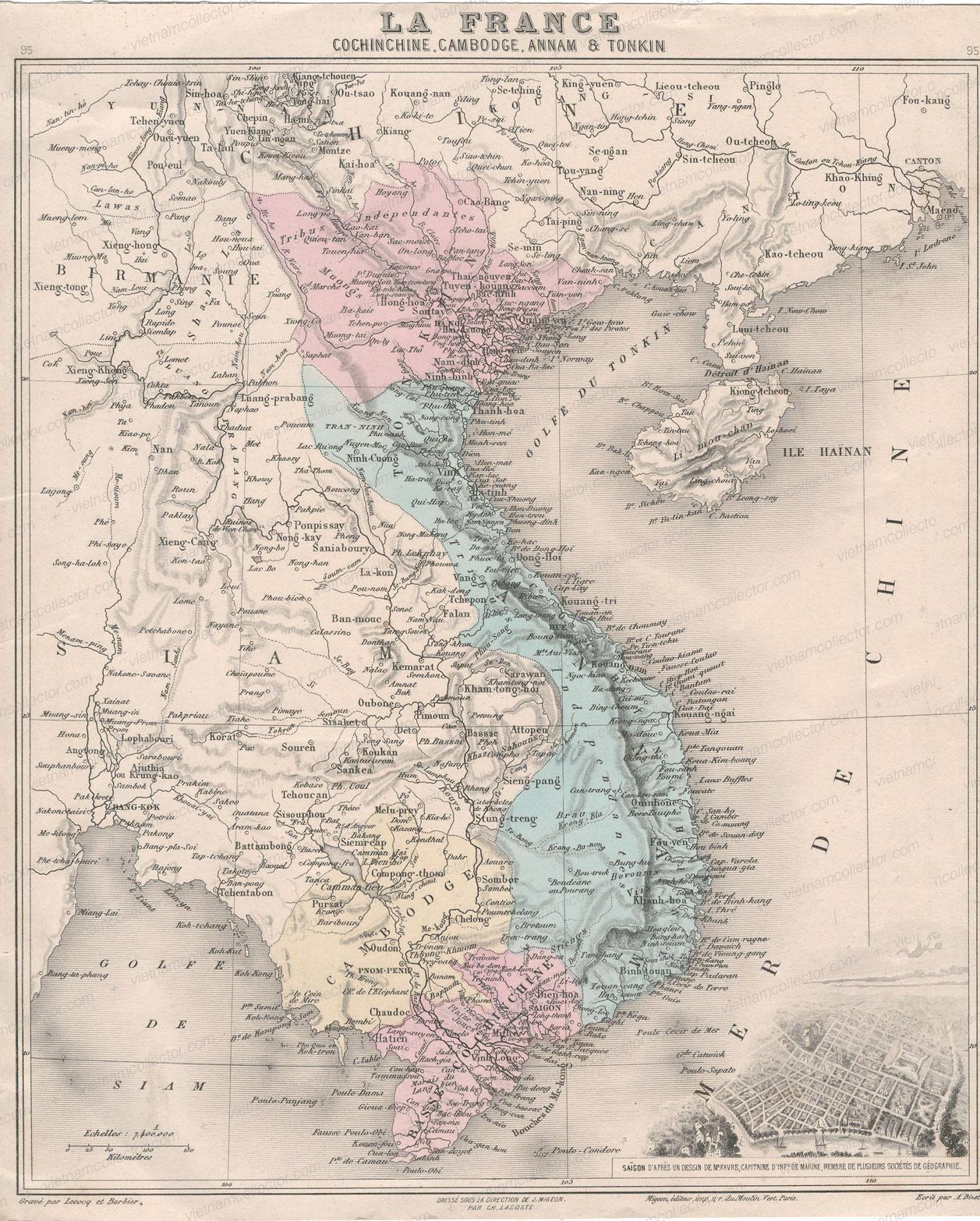
and here a map of the city of Saigon that shows it#s footprint in 1861, just prior to establishment of the protectorate. Note the military citadel in the center of the map.
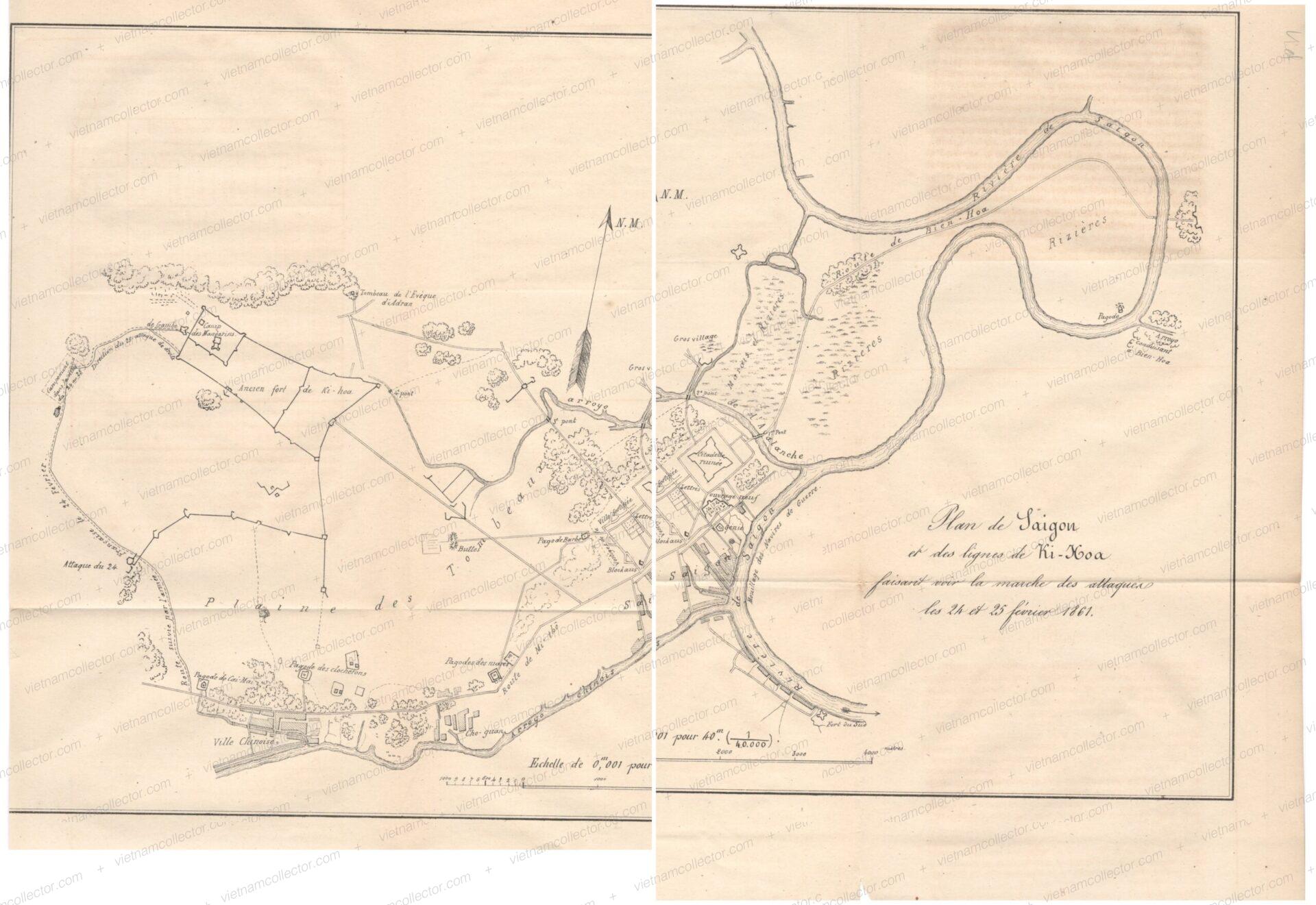
The first military post office was established on February 25th, 1861 in Saigon and the first post office open to the public on January 13th, 1863, also in Saigon. The offices in Haiphong, Hanoi and Hue opened on November 2nd, 1875 and the one in Quinhon on November 24th, 1876. (J.Desrousseaux SICP Journal Nr. 6, February, 1972).
General service stamps for the colonies were cancelled with lozenge cancels up to about mid-1876. After that individual town cancels were employed. J.Desrousseaux provides images of the lozenge cancels in his booklet “Les Posted et Courrriers Francais en Extreme-Orient, Livre 1”:

Many of these town cancels are very rare or are simply inferred to exist based on administrative records. This means no copies of these cancels have been found yet but according to the postal administration a post office was opened and so technically these cancels should exist. In his booklet “Postoffice Names and Other Words in Postmarks Used on the General Issues of French Colonies 1860-1892” by Robert A. Stone the following post offices are listed:
Annam
Recorded Marks: Ninh-Dinh, Bung-Son, Cau-Hai, Cho-Huyen, Dong-Hai, Honcoh, Hue’, My-Tho, Nhatrang, Phan-Tiet, Quang-Nam, Quang-Ngai, Quang-Tri, Quin-Hon, Quinehone, Qui-Nhon, Thuan-An, Tourane, Vinh, Jung-Lam.
Marks not yet recorded: Bong-Son, Camlo, Camranh, Ha-Tinh, Kinhlam, Phare-Padaran, Phan-Rang, Phan-Ri, Phepho, Quan-But, Song-Cau, Tamki, Tuy-Hoa.
Cambodia
Recorded Marks: Banam, Cratie, Corr.D. Armees/G., Corr.D.Armees/BA, Kampot, Kompong-Luong, Krauchmar, Krochmar, Pnum-Penh, Pursat,Rokacong, Takeo, Vapeur No.___
Marks not yet recorded: Kathom, Kompong-Chnang, Kompong-Thom, Kompong-TIam, Kompong-Toul, Kratie, Pnom-Basset, Sambor, Slakou, Soaireng, Stung-Trang
Cochinchine
Recorded Marks: Baclieu, Bactrang, Bayxau, Bake’, Baria, Bactri, Benluc, Bentre’, Bienhoa, Binhoa, Caibe’, Cailay, Camau, Cantho, Cap-Saint-Jacques, Cap-Phare, Chaudoc, Chogoa, Chole’n, Daingai, Giadinh, Gocong, Hatien, Lai-Vung, Longthanh , Longxuyen , Mocay, Nuoc-Xuoai, Poulo-Condore, Rachgia, Sadec, Saigon, Saigon a Mytho, Saigon-Port, Soctrang, Tanan, Tanchau, Tayninh, Thudamnot, Tiencau, Tong-Keou, Tracu, Trangbang, Traon, Travinh, Vapeur No___, Vinhlac, Vinhlong.
Marks not yet recorded: Anhoa, Cainhum, Cangioc, Cangiou, Chogao-Bac, Correspondence Militaire, Goden, Govap, Hocmon, Mang-Thit, Nhabe, Bagne de Poulo Condore, Tanhiep, Thudoc, Tinh-Bien, Vungliem.
Tonkin
Recorded Marks: Bac-Ninh, Bao-Ha, Ba-Hoa, Camkhe, Cao-Bang, Cho-Bo, Dap-Cau, Dong-Dang, Hai-Duong, Hai-Ninh, Hanoi, Hanoi Pagode, Hanoi-Concession, Haiphong, Haiphong, Ha-Tinh, Hon-Gay, Hong-Hoa, Hung-Hoa, Imprimes-Hanoi, Kien-Xuong, Lam, Lang-Kep, Lang-Son, Lac-Kay, Moncay, Na-Cham, Nam-Dinh, Ninh-Binh, Phu-Doan, Phu-Lang-Thuong, Phu-Ly, Phuong-Lam, Quang-Yen, Rivie’re Noire, Sept-Pagodes, Sonla, Son-Tay, Thai-Nguyen, Thanh-Hoa, Than-Quan, That-Khe, Tienyen, Viettri, Yen-Bay.
Marks not yet recorded: Akhoi, Bambous, Chu, Correspondence Militaire, Dong-Song, Hanoi-Recte’, Haiphong-Cochinchine (martime-not an Indochina mark), Huong-Kanh, Kebao, Kep, Kesat, Luc-Dien, Lucnam, Phu-Ninh-GIang, Tambour, Thai-Binh, Than-Moi, Rai-Hut, Ta Xuyen, Tuyen Quang, Van-Bu, Van-Giang.
Laos
The first post office in Laos opened in 1894 so no cancels on general service stamps exist.
The expeditionary focus were enjoying free frank privileges so most of these covers do not carry any stamps, except if they were sent by an officer, who, due to their higher renumeration, had to pay for their mail. Stamps for the colonies were only introduced between 1859 and 1865 and the so called “Eagle” set released in nominals of 1C, 5C, 10C, 20C, 40C and 80C was first used in Cochinchina on June 1st, 1863. Prior to the “Eagle” set the post office in Saigon carried French “Napoleon” stamps from February 25th, 1861 through May 31st, 1863 in nominals of 5C, 10C, 20C, 40C and 80C. Letters posted in Saigon with these “Napoleon” stamps are very rare. The first civilian post office in Cochinchina was opened on January 13th, 1863 and the first public French post offices in Tonkin did not open until January of 1885. The first civilian post office in Cambodia was opened on January 1st, 1873. (Desrousseaux, SICP Journal, February 1972, Volume 2, Nr. 1). From 1871 through 1872 the Napeoleon III series was introduced in nominals of 1C, 5C, 30C and 80C were introduced. The Ceres set with nominals of 10C, 15C, 20C, 25C, 30C and 40C followed in 1871 through 1877. The Pax & Mercur series was issued between 1877-1880 and saw nominals of 1C, 2C, 4C, 5C, 10C, 15C, 20C, 25C, 30C, 35C, 40C, 75C and 1 FF. The Alphee Dubois series was issued between 1881-1886 and saw nominals of 1C, 2C, 4C, 5C, 10C, 15C, 20C, 25C, 30C, 35C, 40C, 75C and 1FF. The use of these stamps in Indochina can only be documented by a legible cancel or on complete postal history.
Rare multiple franking of the 10C General Colony stamps on an early international letter sent by a military officer from Saigon to France in May of 1864 paying the military letter rate of 20C. Stamps cancelled with the lozenge cancel “CCH” Type 2 Desrouseaux (applied upside down and with weak impression of the two C’s). Very rare use of the early “CORR D’ARMEES SAIGON” military cancel (Type a1 Desrousseaux) in blue color. The cancel arrived in Indochina at the end of 1862 with the formal establishment of the protectorate. and was used for a very short period only (Le Postes et Courriers Francais en Extreme-Orient Livre 1, J.Desrousseaux). The letter was likely transported by the Paquebot “Donnai” that left Saigon on May 30th, 1864 (Page 28, La Poste Maritime Franchise Historique et Catalogue by Raymond Salles). A picture of the ship in dry dock can be found on the website of messageries.maritimes.org: 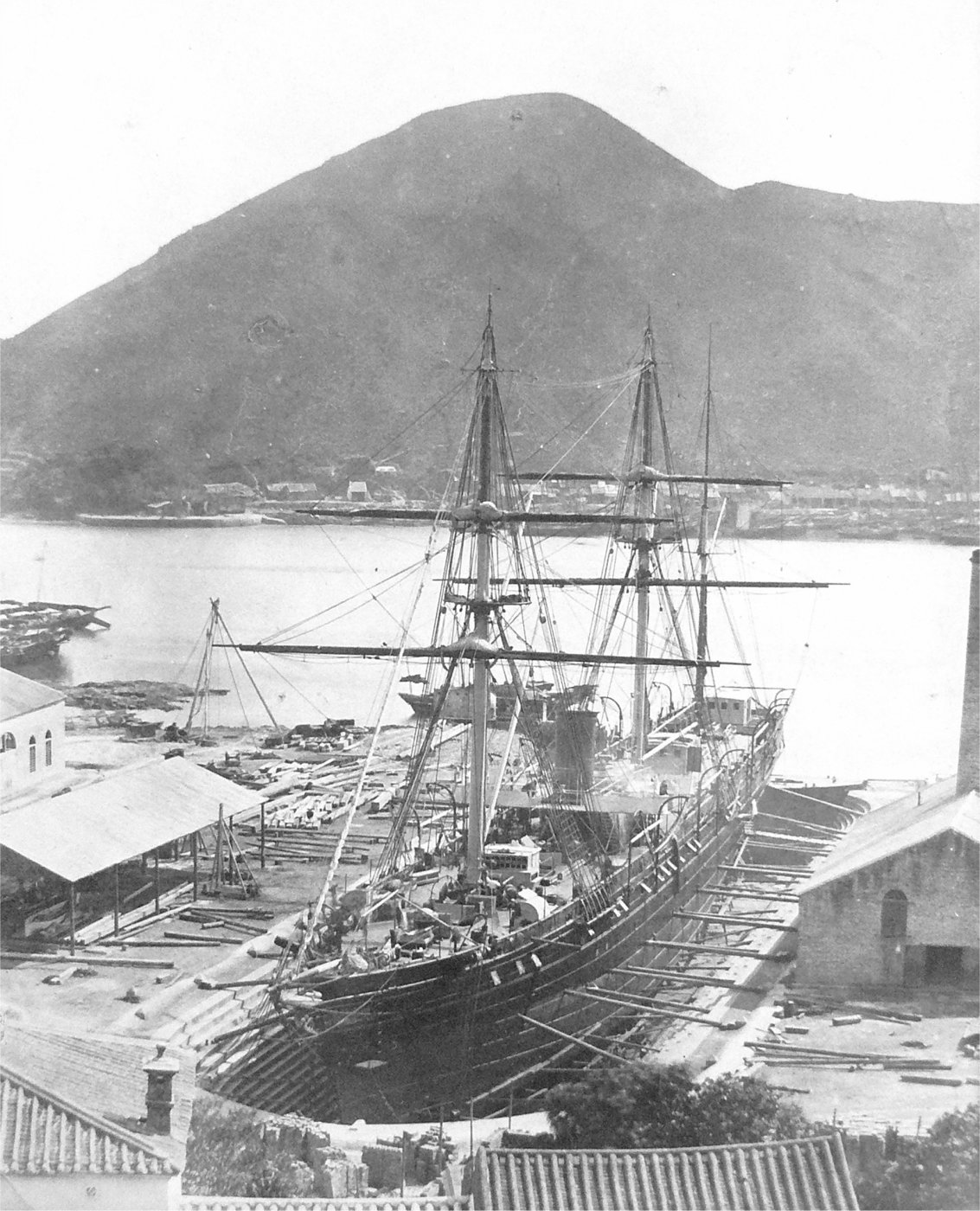 Further cancelled by the mobile octagonal railroad cancel “COL.FV SUEZ PAQ F AMB.MARS.2” (Nr. 1.863 in La Poste Maritime Franchise Historique et Catalogue by Raymond Salles). The ambulant cancel was used on the railroad between Marseille and Lyon. French arrival cancel on the reverse.
Further cancelled by the mobile octagonal railroad cancel “COL.FV SUEZ PAQ F AMB.MARS.2” (Nr. 1.863 in La Poste Maritime Franchise Historique et Catalogue by Raymond Salles). The ambulant cancel was used on the railroad between Marseille and Lyon. French arrival cancel on the reverse.
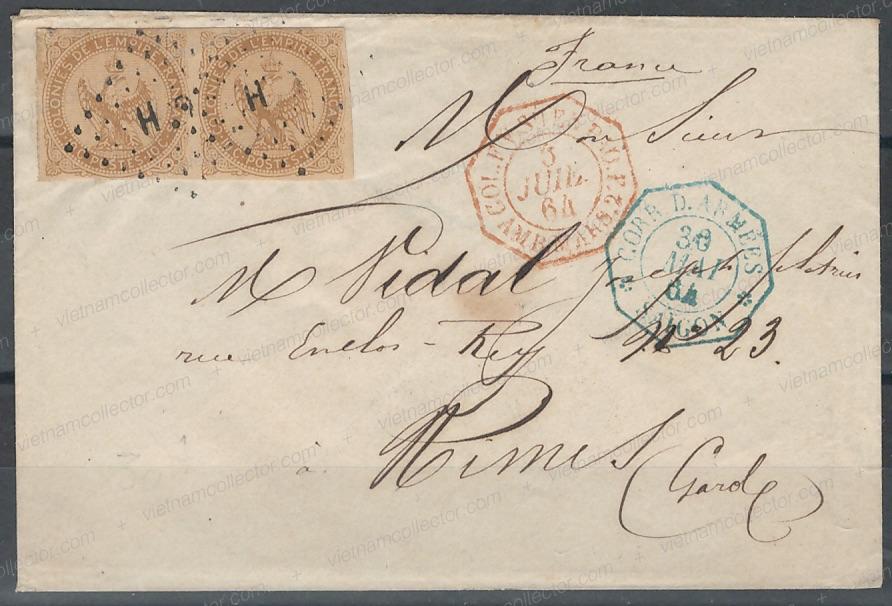
Unit of four 10C General Colony stamps on a letter fragment cancelled with the circular Saigon data canceller from April 1870 and the diamond shaped cancel CCH (Desrousseaux Type 3) and red ship transit cancel.
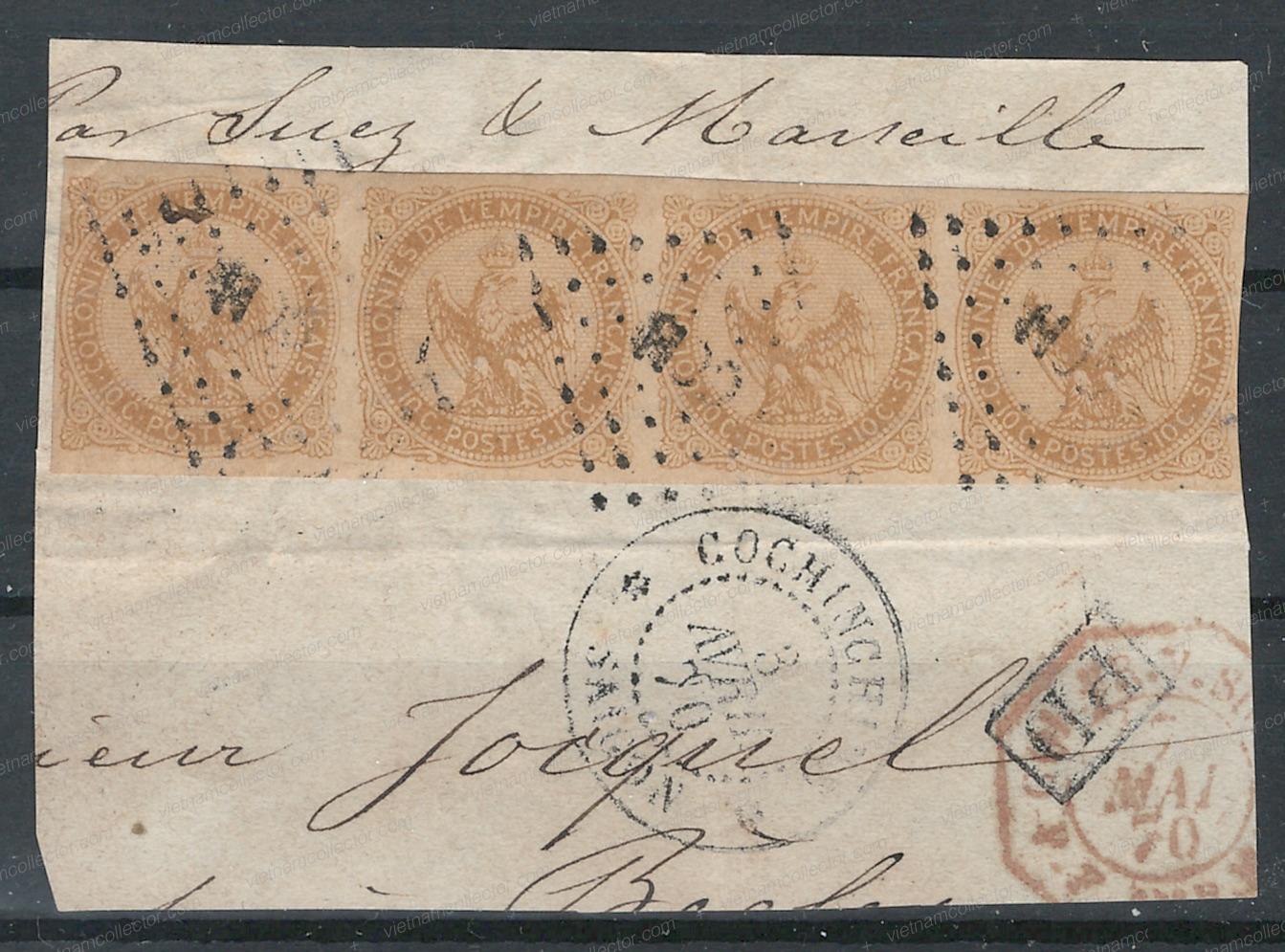
Below is a mixed franking featuring the 20C Eagle and the 5C Napoleon II stamp paying an overall postage of 25C on a very rare letter sent from Saigon to the Island of Guadeloupe (also a French colony). This is very unusual and rare destination. Cancelled with the diamond shaped cancel “CCH” (Desrousseaux Type 3) along with a Correspondances d’ Armees side cancel (Desrousseauc Type “a”) from Saigon. Red boxed “PP” cachet on front. Marseille and Paqebot “Etranger” naval transit cancels. Bas de Terre Gudaele arrival cancel on the reverse. The letter took about 2 months to get to the destination.
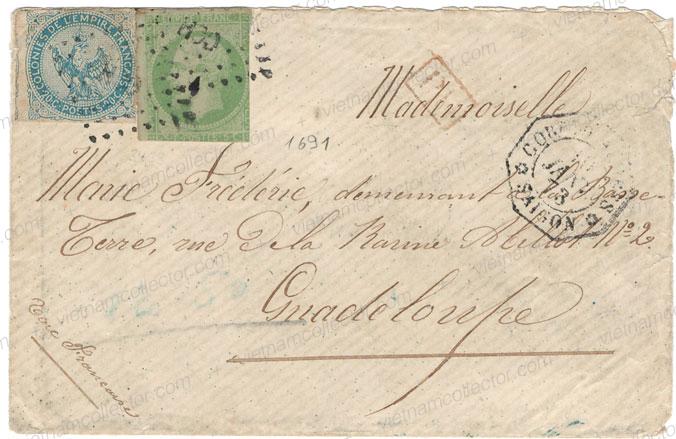
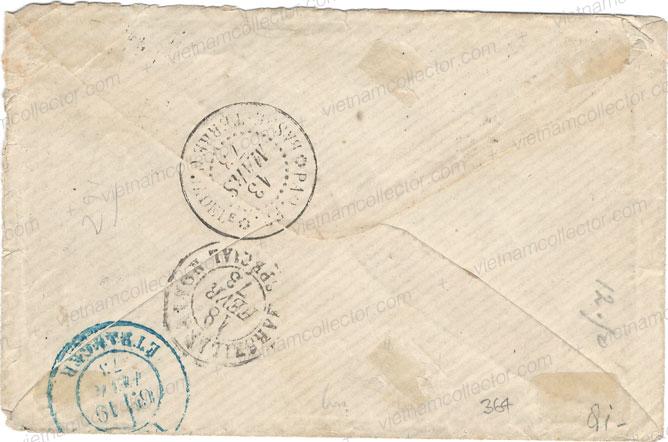
Single 20C Eagle stamp cancelled with the diamond shaped CCH (Desrousseaux Type 3) cancel.
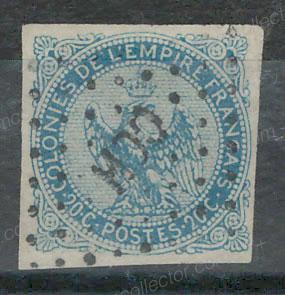
Single 40C Eagle stamp cancelled with the diamond shaped CCH (Desrousseaux Type 3) cancel.
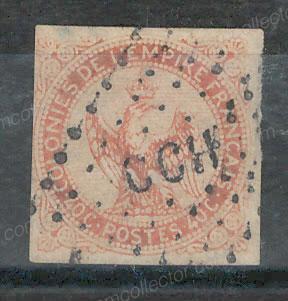
Single 10C and 40C general color stamp cancelled with the diamond shaped CCH (Desrousseaux Type 3).
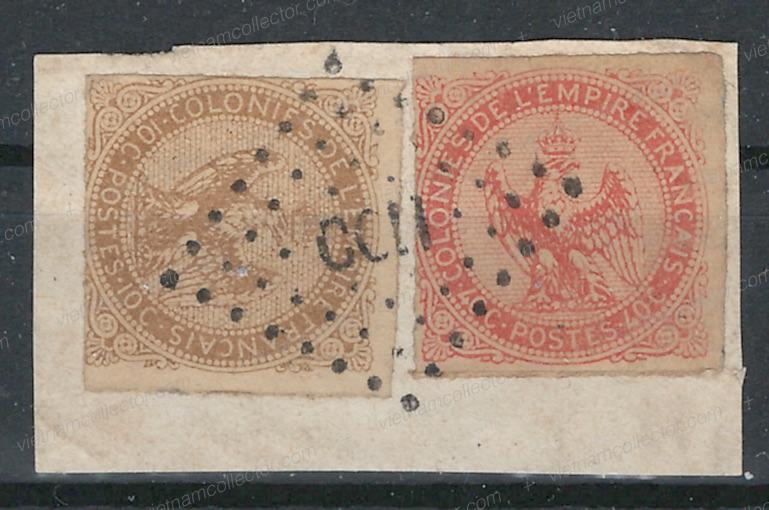
Single 80C Eagle stamp cancelled with the diamond shaped CCH (Desrousseaux Type 3) cancel.
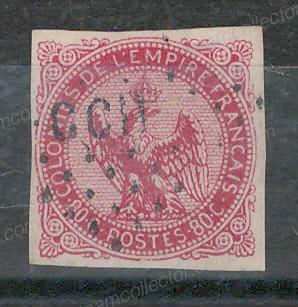
Single 5C Napoleon III stamp canceled with the diamond shaped CCH (Desrousseaux Type 3) cancel.
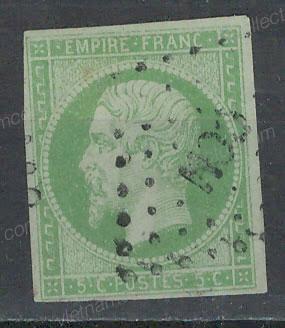 Single 1C Ceres stamp cancelled with the circular Saigon, Cochinchine cancel (Desrousseaux B2).
Single 1C Ceres stamp cancelled with the circular Saigon, Cochinchine cancel (Desrousseaux B2).
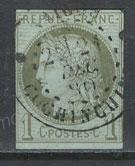
Single of the 5C Ceres stamp cancelled with the circular Cochinchine, Saigon cancel (Desrousseaux Type A). Partial imprint of the red boxed “PP” cachet.
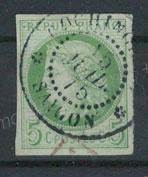
Pair of the 5C Ceres stamp from cancelled with the circular Saigon, Cochinchine cancel (Desrousseaux B2).
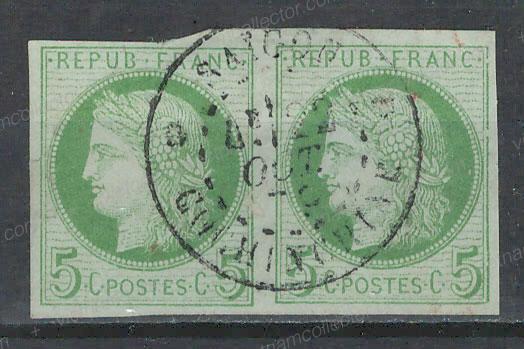
Strip of three 5C Ceres stamps canceled with the diamond shaped CCH (Desrousseaux Type 3) cancel.

Single 10C Ceres stamp cancelled with the circular Cochinchine-Saigon cancel (Desrousseaux A).
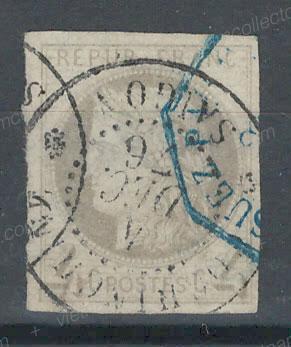
Single 15C Ceres stamp cancelled the circular Saigon, Cochichine cancel (Desrousseaux B2)
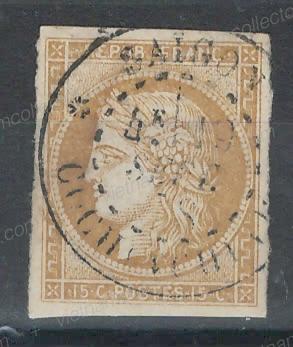
Single 20C Ceres stamp cancelled the circular Saigon, Cochinchine cancel (Desrousseaux B2)
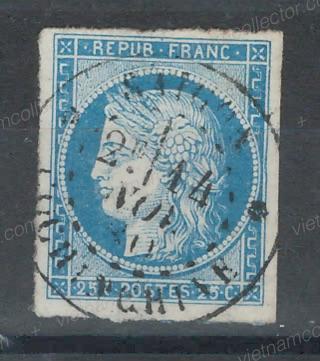
Single 40C Ceres stamp cancelled with the circular Saigon, Cochinchine cancel (Desrousseaux B2).
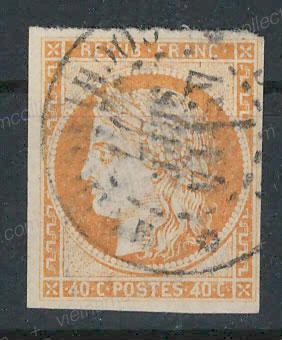
Single 80C Ceres stamp cancelled with the diamond shaped CCH cancel (Desrousseaux Type 3).
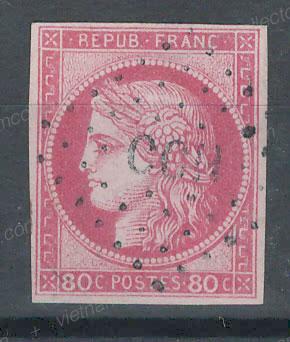
Single 1C Pax and Mercur stamp cancelled with the circular Saigon, Cochinchine cancel (Desrousseaux B2).
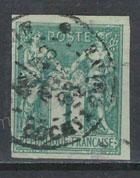
Single 2C Pax and Mercur stamp cancelled with the circular Tonkin cancel (Desrousseaux Type A).
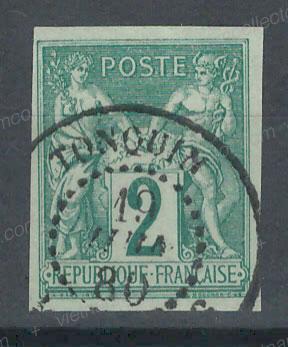
Single green 4C Pax and Mercur stamps cancelled with the circular Saigon, Cochinchine cancel (Desrousseaux B2).
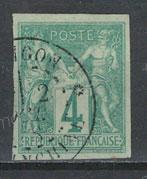
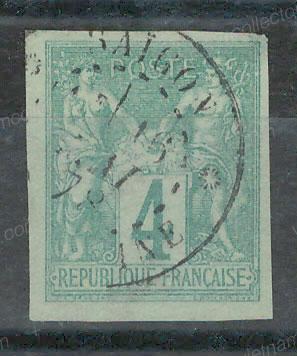
Single brown 4C Pax and Mercur stamps cancelled with the circular Cochinchine-Hai-Phong cancel (Desrousseaux Type A).
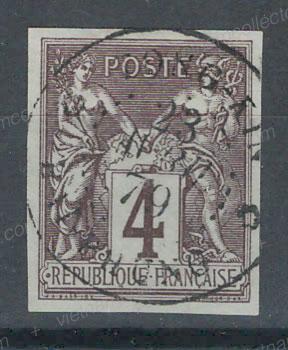
Single green 5C Pax and Mercur stamps cancelled with the circular Cochinchine-Saigon cancel (Desrousseaux Type A).
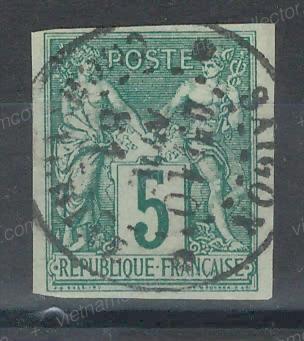
Single 25C Pax and Mercur stamp cancelled with the circular Cochinchine-Hai-Phong cancel (Desrousseaux Type A).
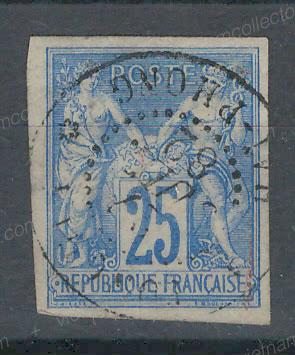
and here the same stamp but this time with the circular Saigon, Cochichine cancel (Desrousseaux Type A)
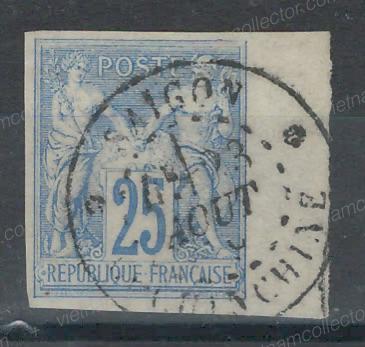
Single 40C Pax and Mercur stamp cancelled with the circular Cochinchine-Saigon cancel (Desrousseaux Type A).
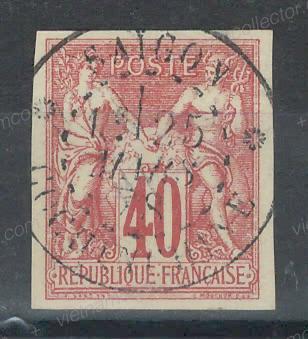
Single 1F Pax and Mercur stamp cancelled with the circular Cochichine-Saigon cancel (Desrousseaux A).
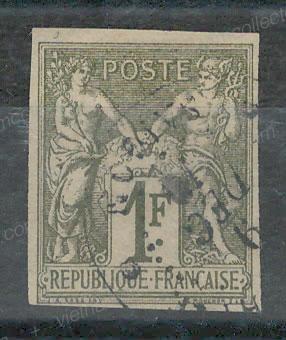
Two 5C Alphee Dubois stamps cancelled with the circular Hai-Phong-Cochinchine or Hanoi cancel (Desrousseaux B2).
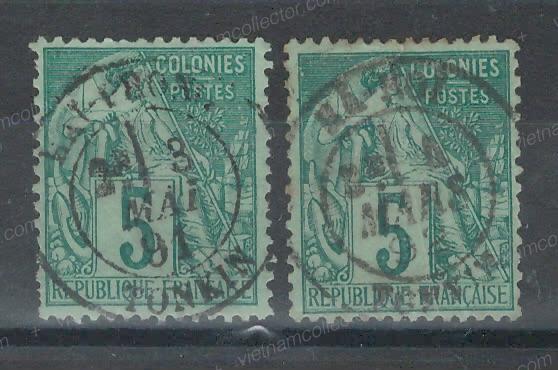
P{air of the 5C Alpha Dubois stamps cancelled in Cambodia (city illegible)
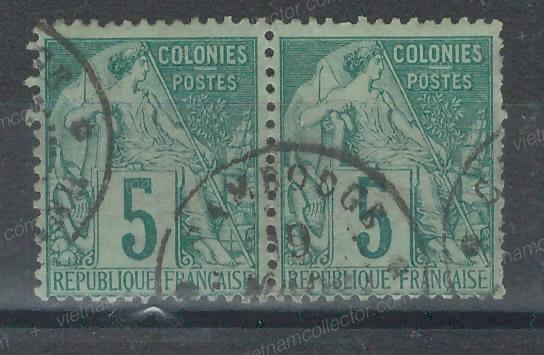
Single 15C Alphee Dubois stamp cancelled with the circular Saigon-Cochinchine cancel (Desrousseaux B2).
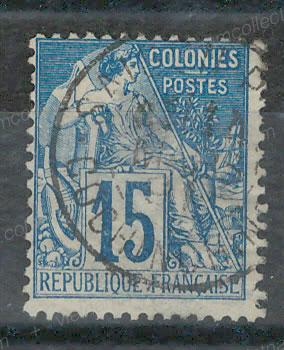
Single 25C Alphee Dubois stamp cancelled with the circular Saigon-Cochinchine cancel (Desrousseaux B2).
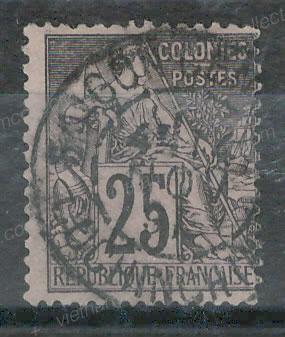
Single 25C Alphee Dubois stamp cancelled with the circular Bac-Nin-Cochinchine cancel (Desrousseaux B2).
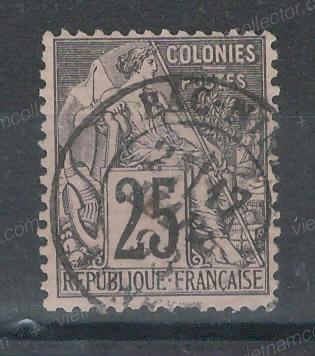
While some colonial French postage due stamps had already been overprinted with new values for Indochina in 1904 (Michel Nr. IND P1-4) Indochina kept using French postage due stamps with inscription “RF” until at least 1913. It is thought that this was due to the fact that the overprint issue did not cover all required nominals and that there were still significant stocks of the French stamps in the post offices which first had to be used up. These “forerunner” stamps can only be identified by the postal cancel. Here is an assortment of 1C, 2C, 3C, 4C, 5C, 10C, 15C, 20C, 30C, 50C, 60C, 1Fr. and 2Fr. postage due stamps with Indochinese cancels.
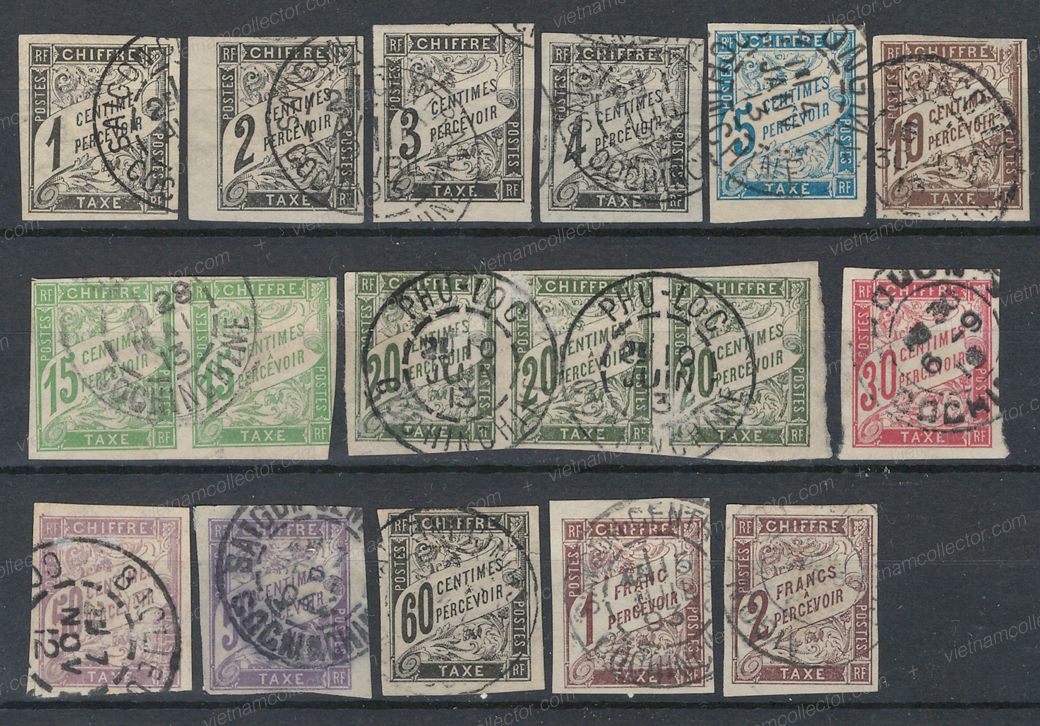
Pair of there 5C postage due stamps bearing the rare cancel of Xiang-Khouang, Laos.
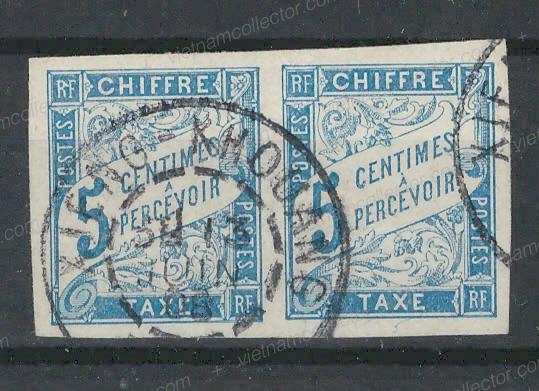
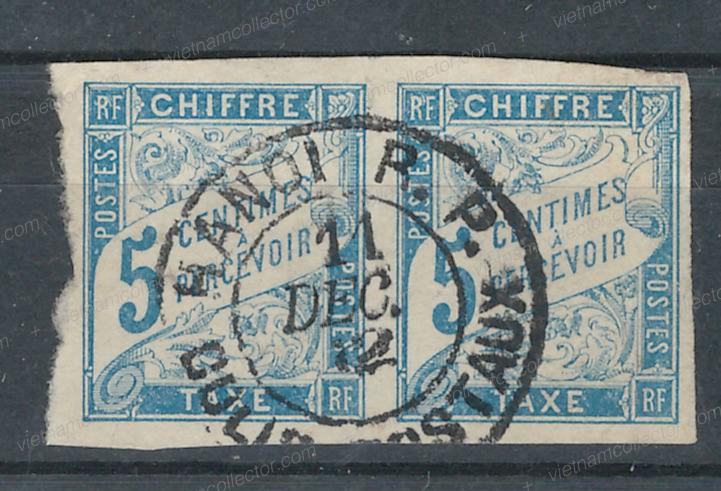
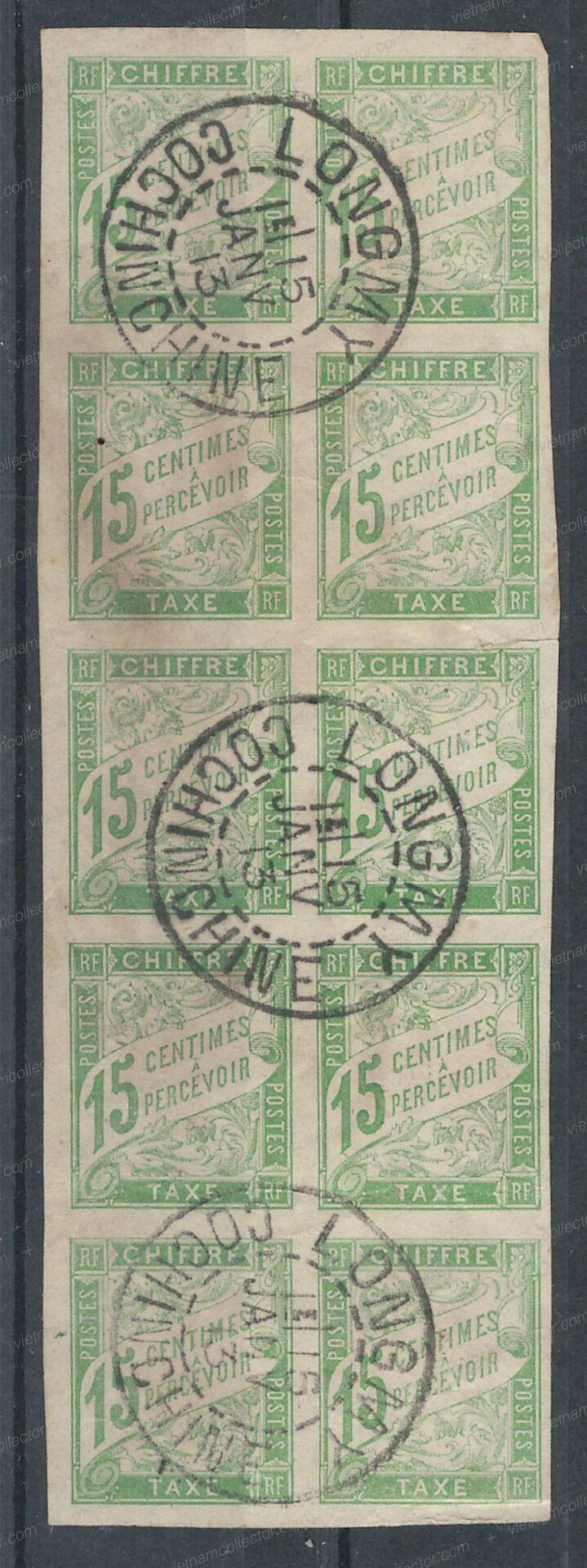
International postcard sent from in December of 1904 from Algeria to Saigon. The postcard was under-paid in Algeria and hence was taxed with a 10C penalty for postage due upon arrival in Saigon. This was paid by adding two 5C postage due stamps. Saigon arrival cancels.
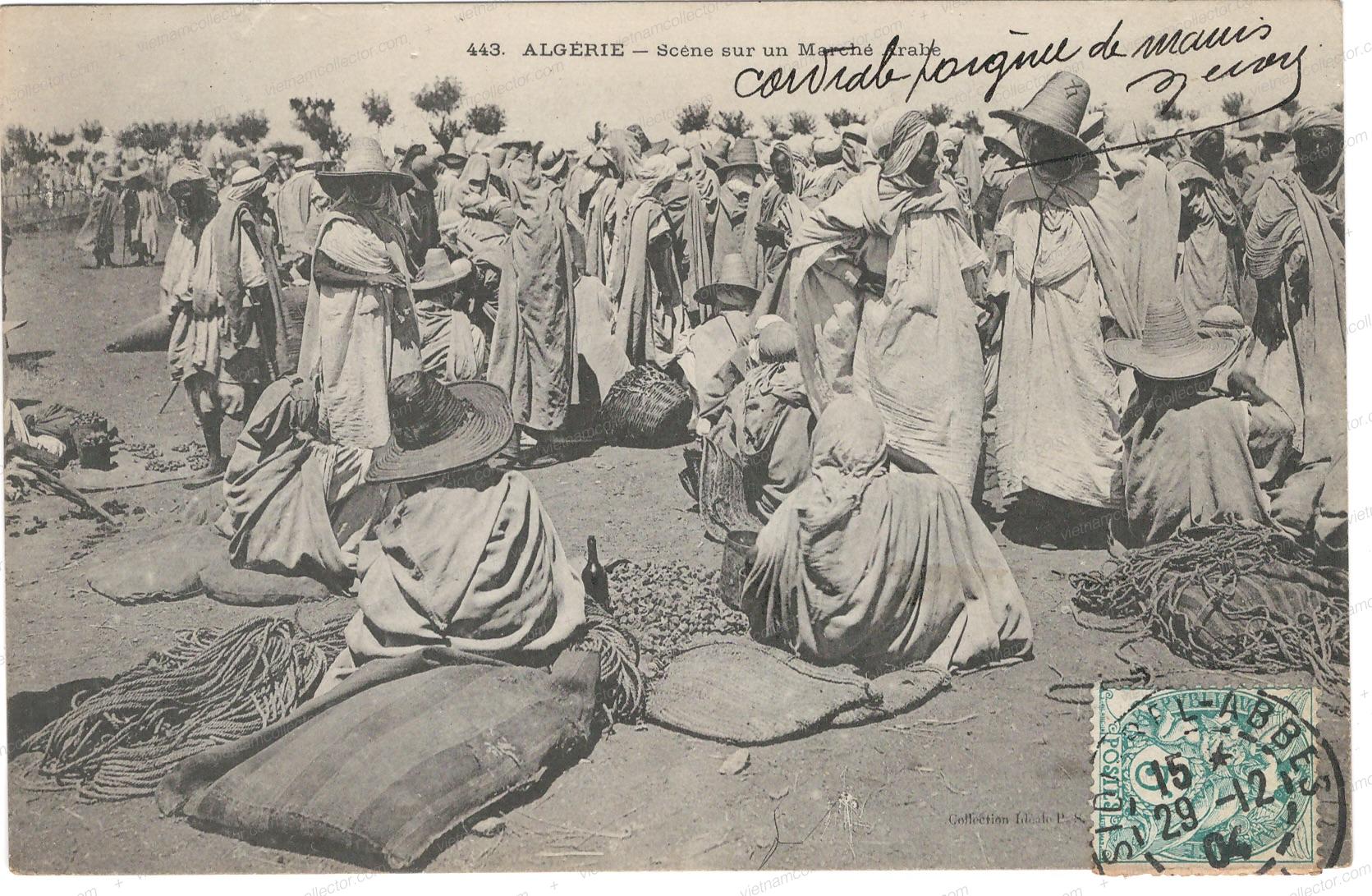
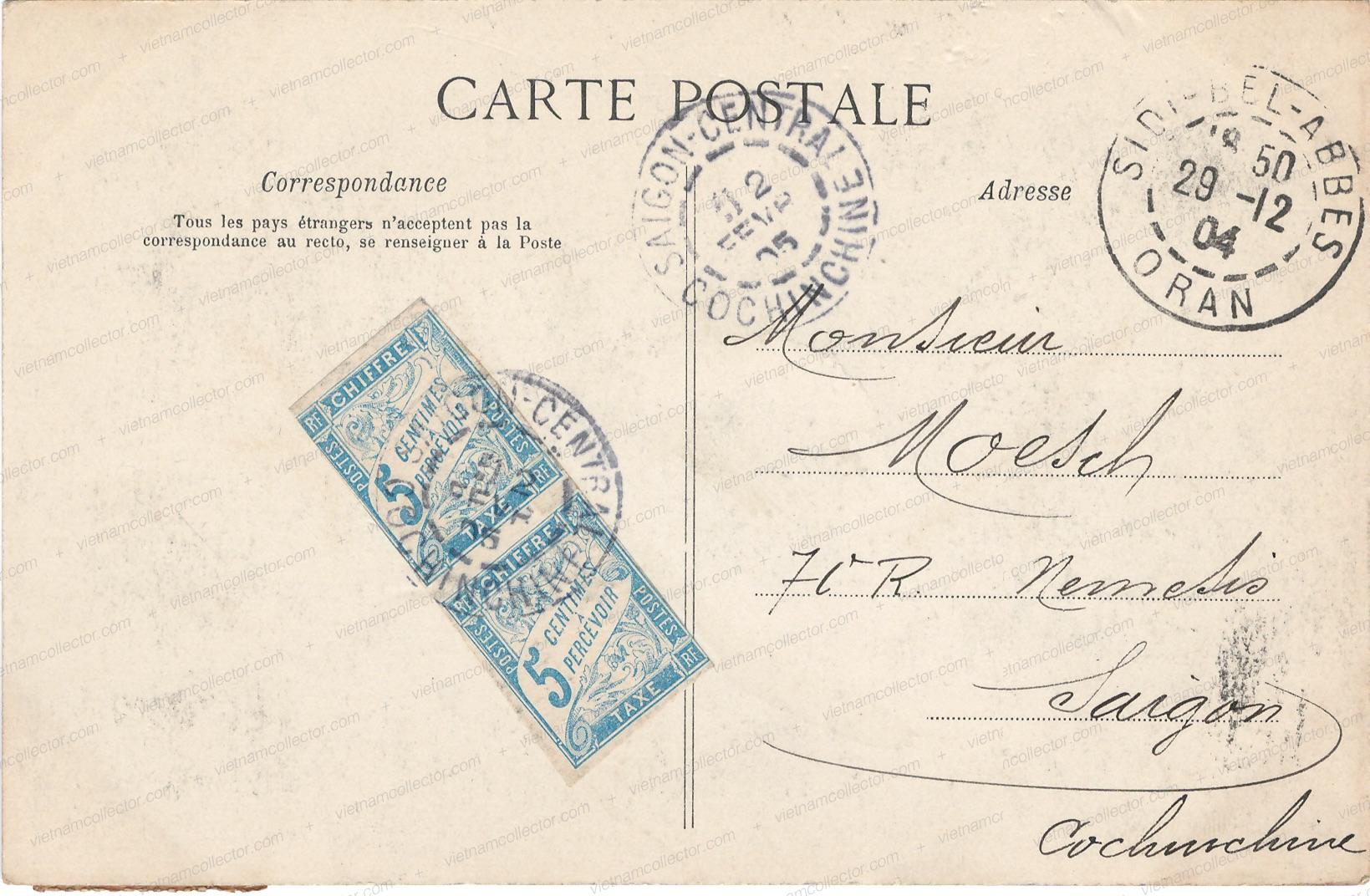
Domestic letter sent by the Saigon Justice of the Peace Registry in 1909 to a civilian in Saigon. The letter was posted without postage and as a result a 20C French postage due stamp was added in front on cancelled with the Saigon-Central date canceller.
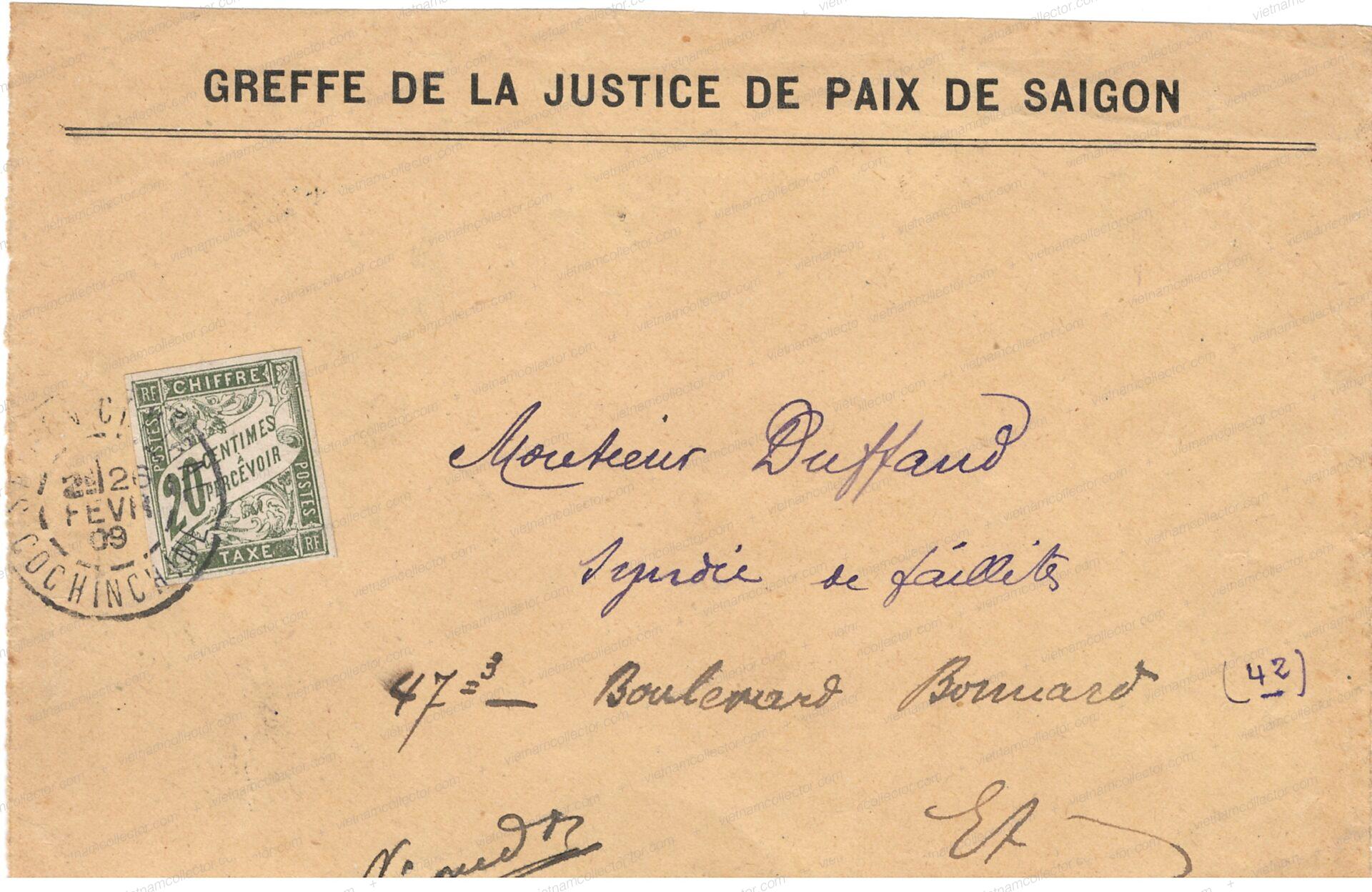
International letter sent by the Head of the Veterinarian Service in Saigon to France in April of 1912. The letter was posted without any postage and as a result it received a triangular “T” hand stamp in Saigon that additional postage was due upon delivery. In Paris a perforated 20C French postage due stamp was added to the envelope and unusually cancelled by the triangular Paris postage due mark.
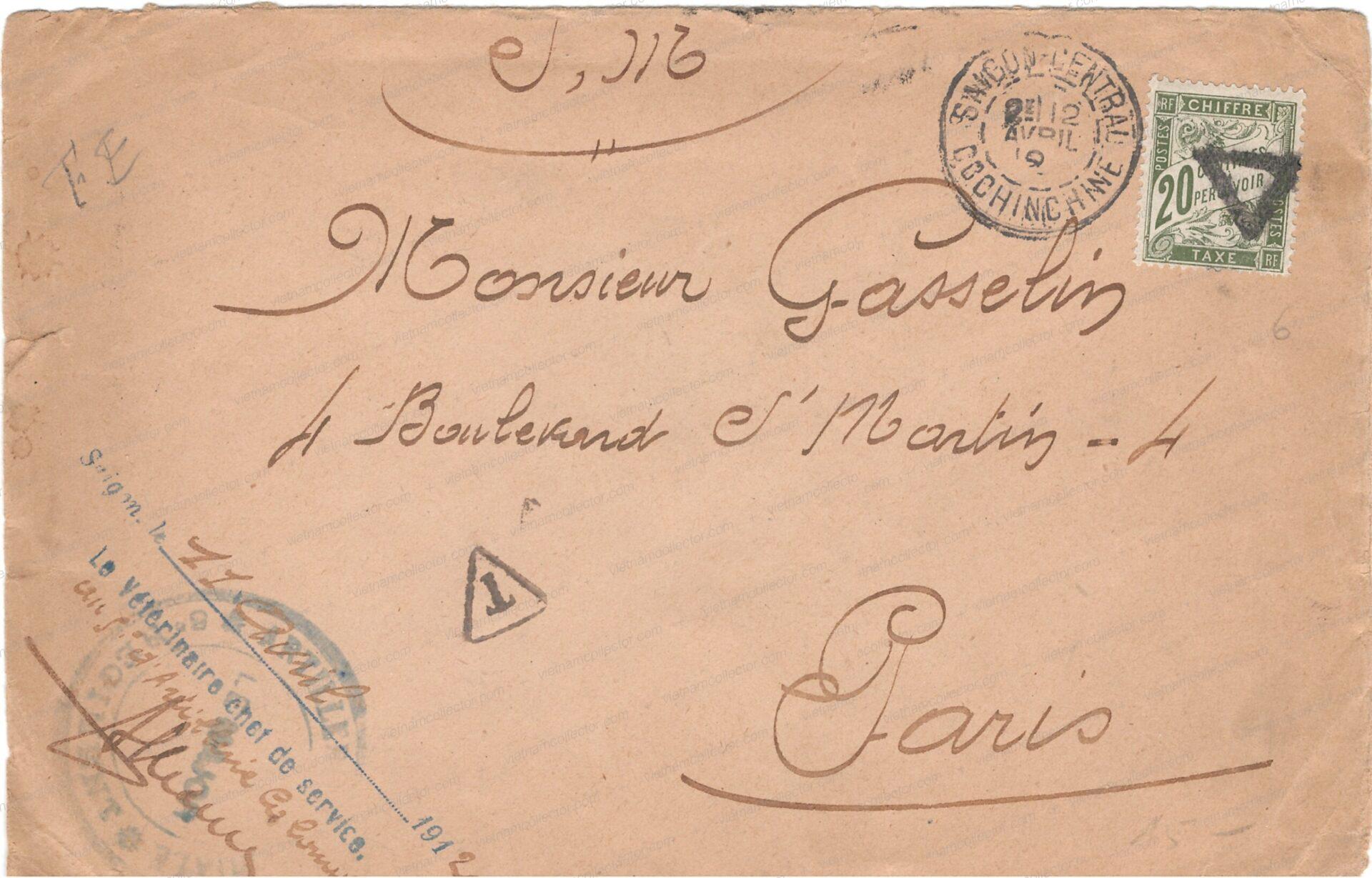
International letter sent fro India to Hanoi in April of 1909. The letter was posted without any postage and as a result it received a “T” hand stamp in a circle in India that additional postage was due upon delivery. In Hanoi two 20C and two 5C French postage due stamp were added to the envelope and unusually cancelled by the Hanoi circular cancel. Transported by Ligne N Nr. 6 as indicated by the octagonal ship cancel on front. Indian transfer cancel on the reverse.
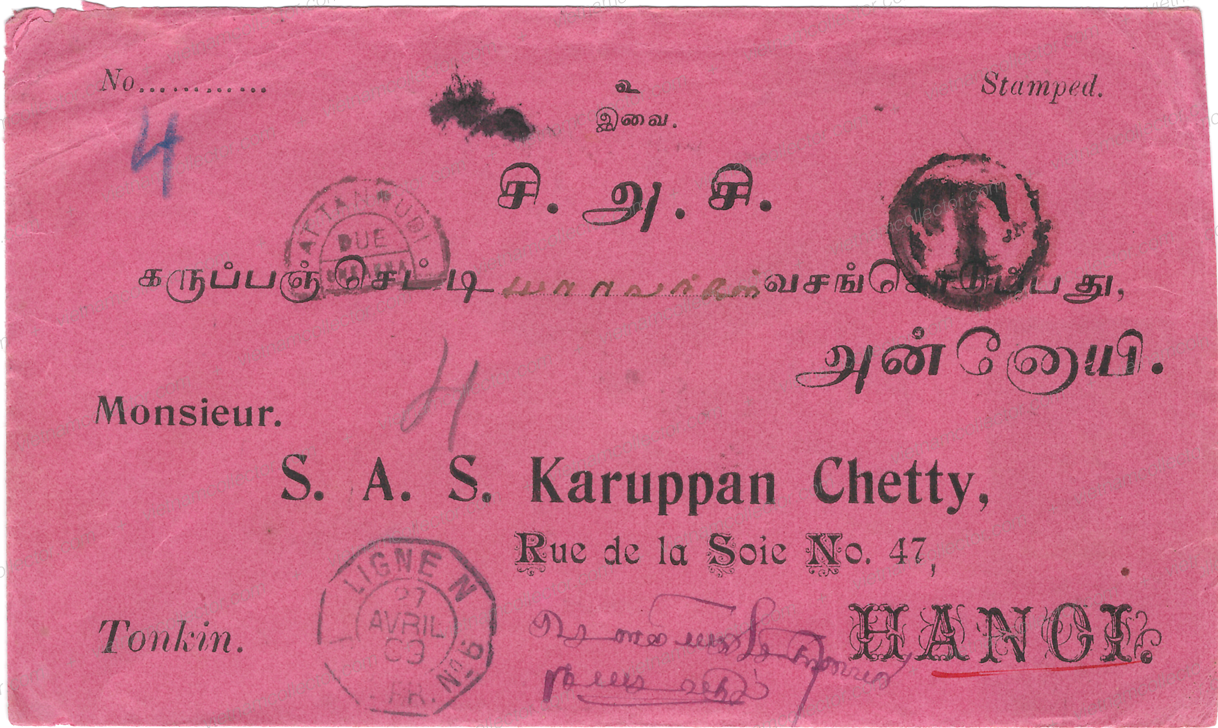
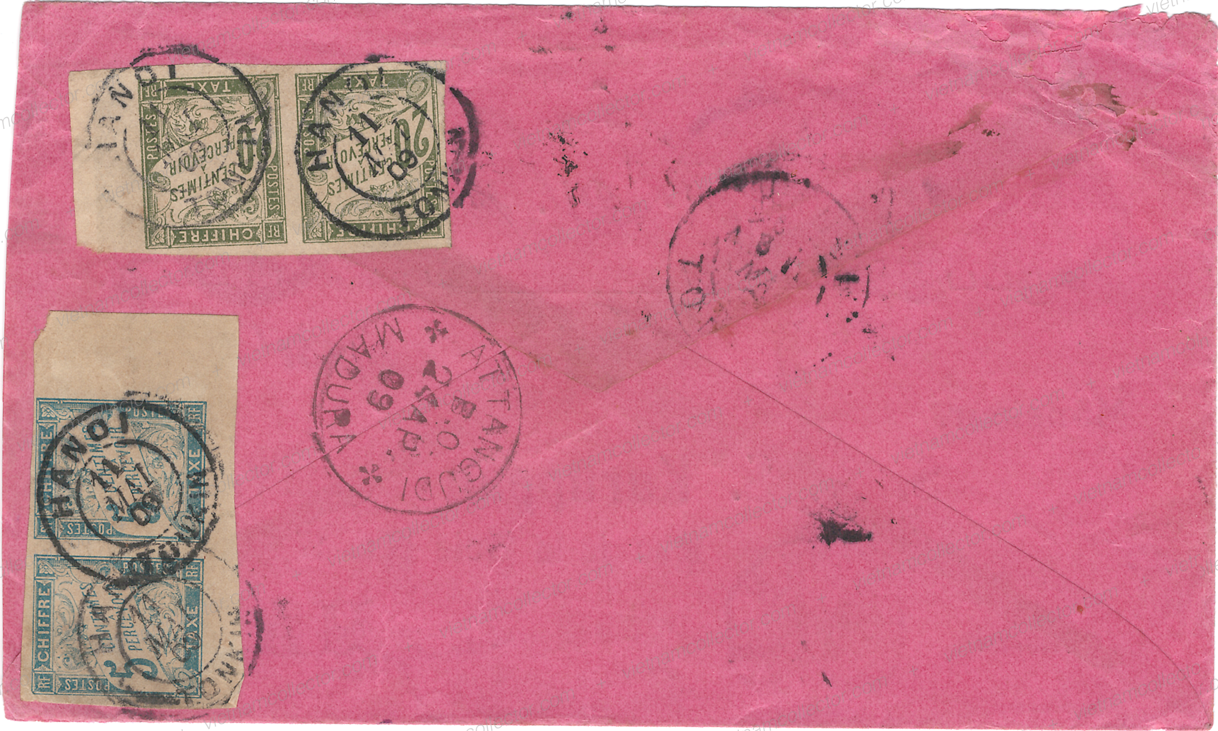
International letter sent from India to Saigon in July of 1907. The letter was franked with 1 Anna in postage which was insufficient. As a result the letter received a black “T” hand stamp in a circle in India indicating that additional postage was due upon delivery. In Saigon the postal clerk added the number “15” in manuscript and a 30C postage due stamp for the twice this amount (15C missing postage plus 15C in penalty) was added and cancelled with the standard Saigon circular canceler.
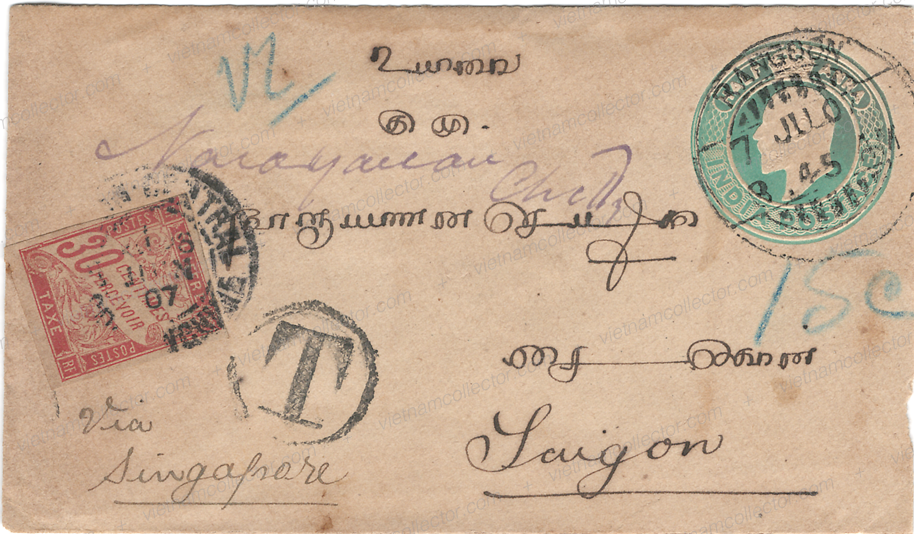
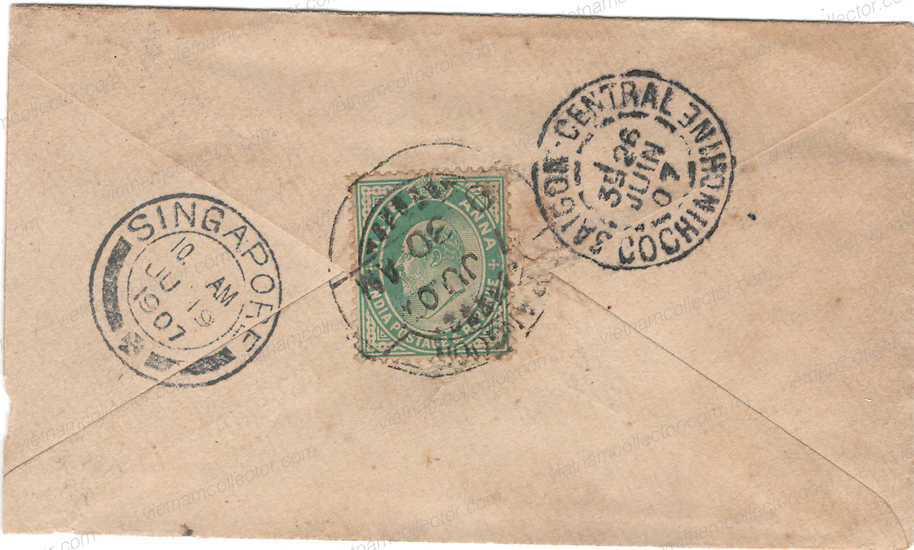
International letter sent from India to Saigon in April of 1903. The letter was franked with 1/2 Anna postage which was insufficient. As a result the letter received a black “T” hand stamp in a circle in India indicating that additional postage was due upon delivery. In Saigon the postal clerk added the number “40” in manuscript and a postage due stamp for the same amount was added and cancelled with the standard Saigon circular canceler.
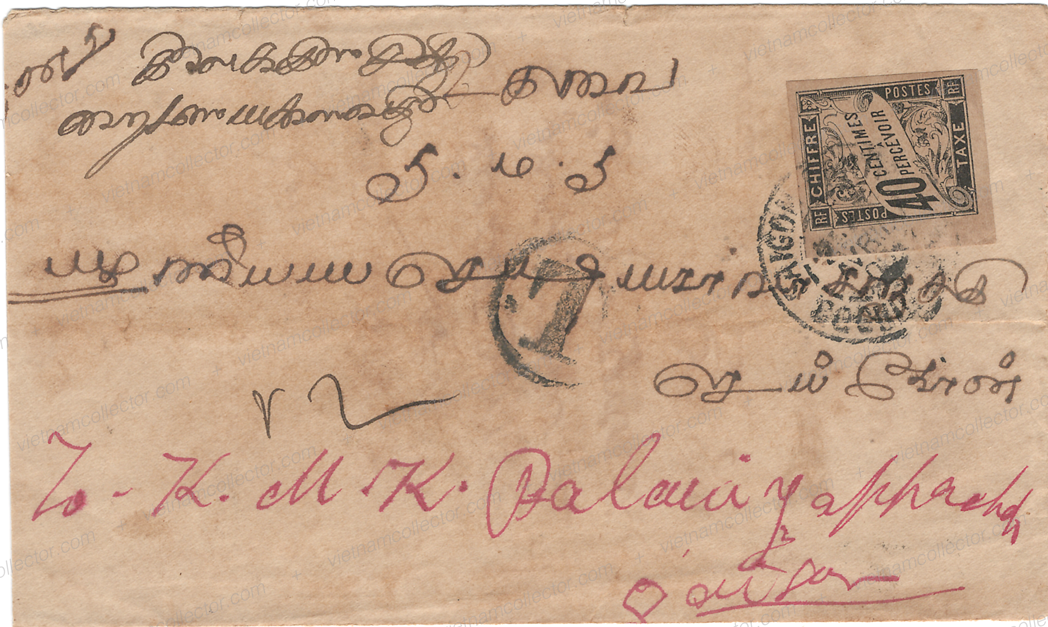
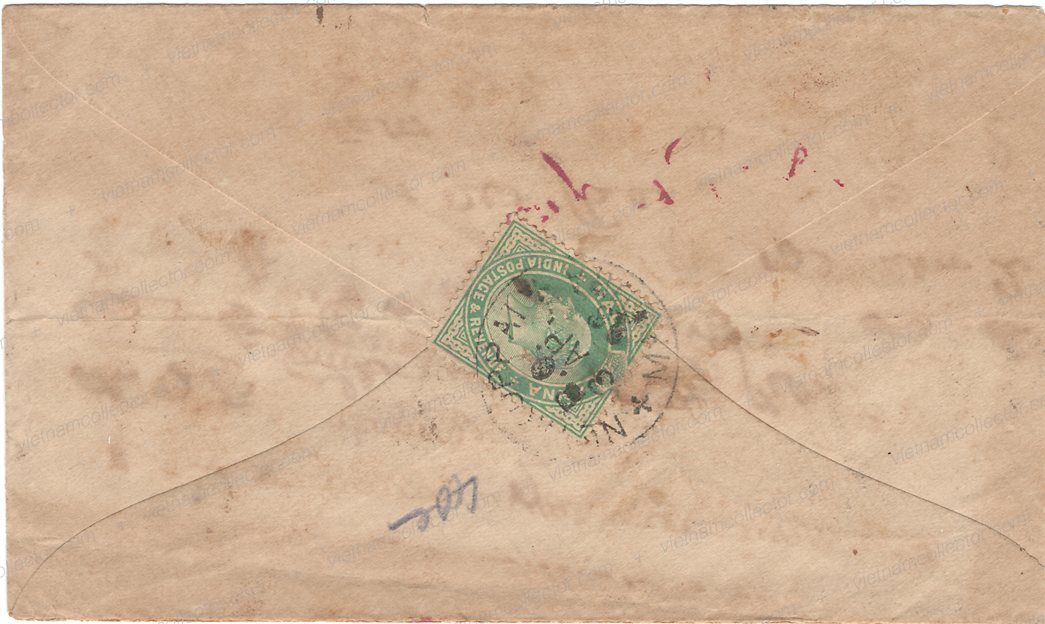
Two rare used postal stationaries of the 1C Pax & Mercur series from 1877 that was used in Yen-Ba and Saigon respectively to ship a newspaper in June of 1891 and July of 1890. The piece from Yen-Ba also shows an arrival cancel on the reverse.
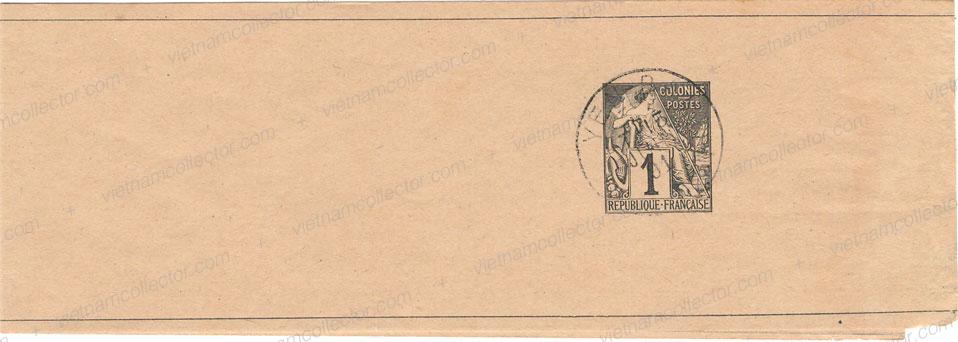

Postal stationary used to mail newspapers imprinted with the 3C Alpha Dubois stamp and mailed in September of 1897 from Hai Phong to Germany.
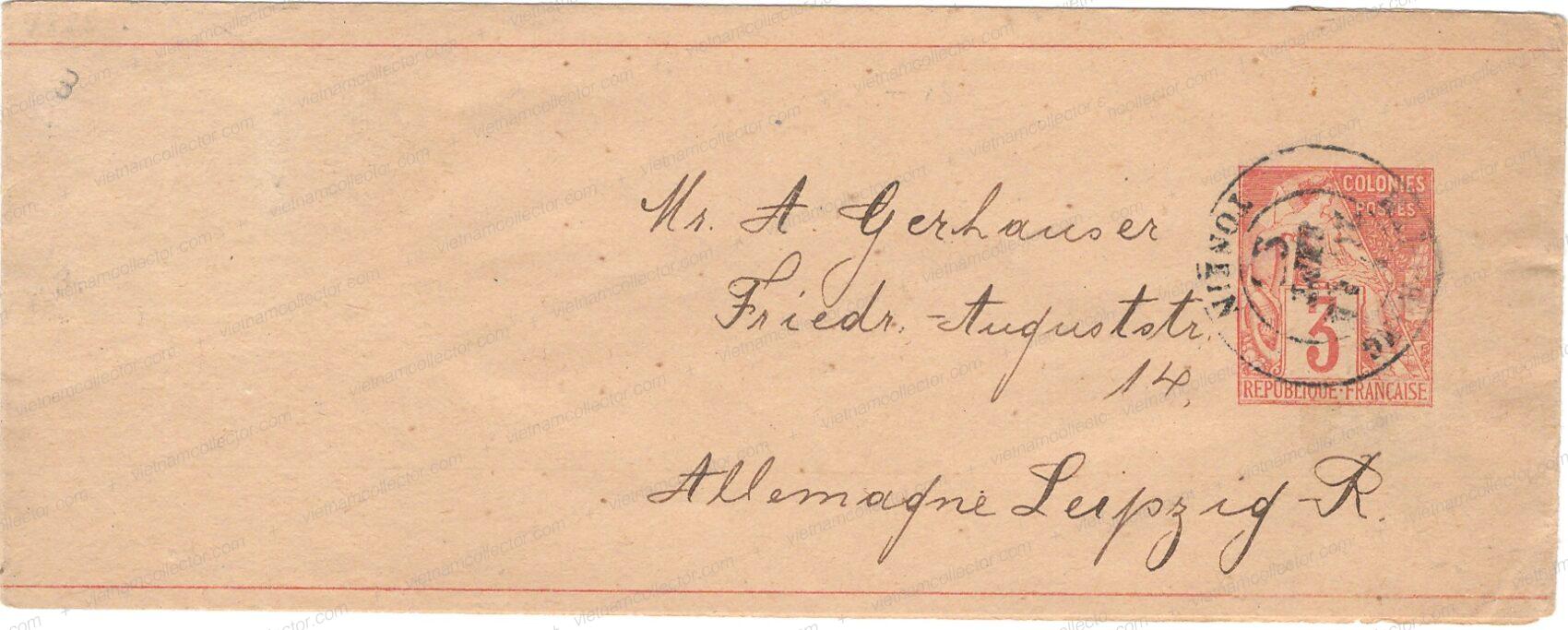
Postal stationary of the 5C Alphee Dubois series used on a small domestic letter sent within Saigon in December of 1892.
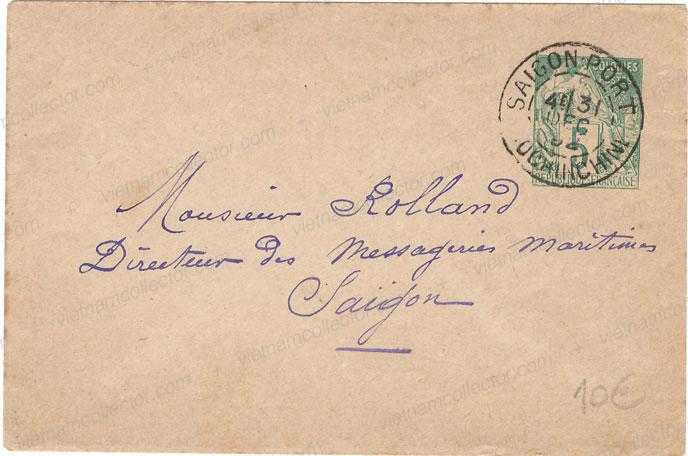
Postal stationary of the 5C Alphee Dubois series for cancelled with the Saigon Central Post Office.

Mixed franking of the 5C Alphee Dubois series unfranked with two 10C Alphee Dubois stamps paying the overseas tariff of 25C on an international letter sent from Tourane (Da Nang) to Paris, France in January of 1893.Saigon truant and Paris arrival cancel on the reverse.

Postal stationary of the 10C Alphee Dubois series used on domestic post card sent in November of 1900 from My Tho to Saigon.
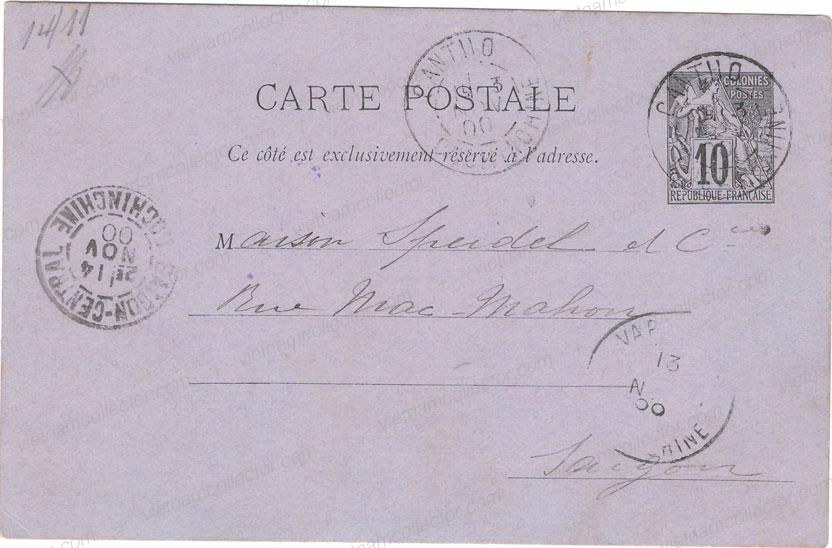
Complete set of the response post card of the 10C Alphee Dubois series with favor cancel from the Saigon Central Post Office.
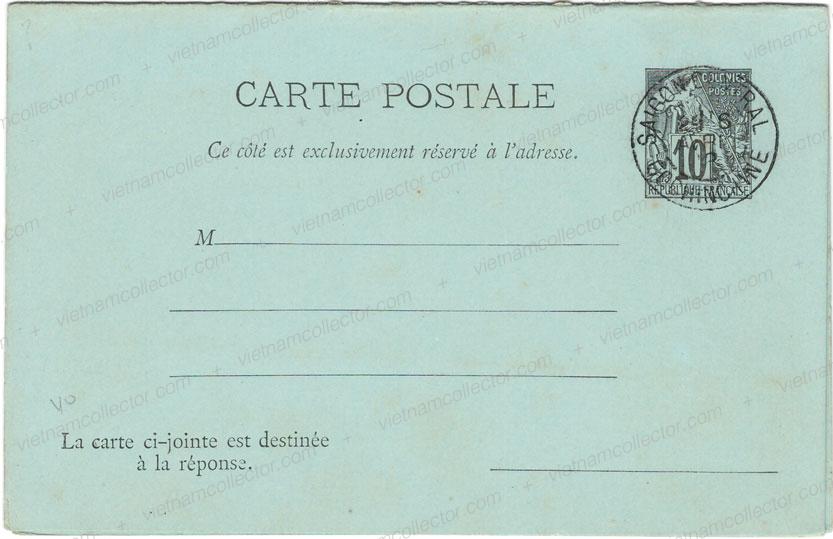
Return Portion

Letter sent by the “Mission Navale de L’Extreme Orient” featuring the perforated 15C Alphee & Dubois series on a military letter sent from Saigon to Suez, Egypt in 1901. Contrary to general service members officers had to pay postage for their letters on account of their higher renumeration.Cancelled with the octagonal Indochina-Saigon cancel (Desrousseaux Type A). Poste Naval-Service a la Mer cachet on front. Illegible transit/arrival cancel on the reverse.
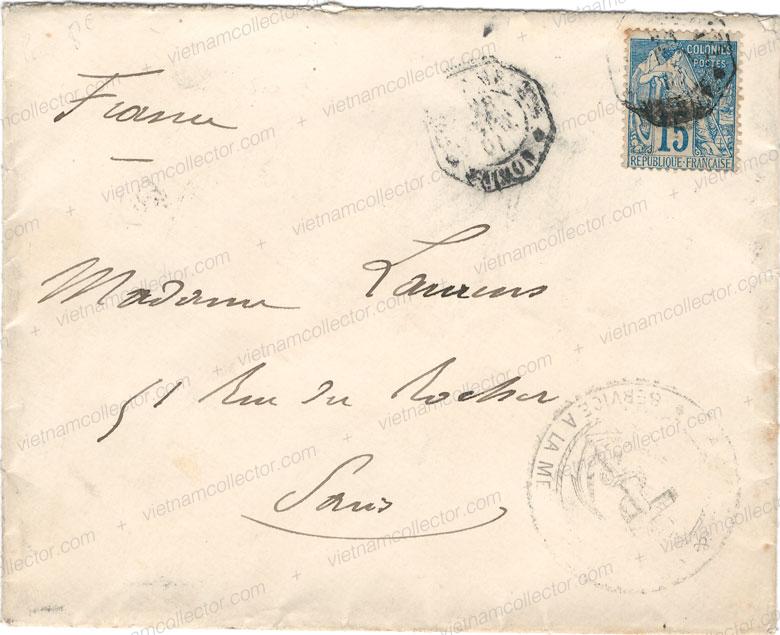
Single franking of the imperfroate 15C stamp on an international military letter sent by an officer to France in January of 1880. The letter was cancelled with the “mute” Corr. de Armee octagonal cancel. Circular red paqueboat cancel on front.
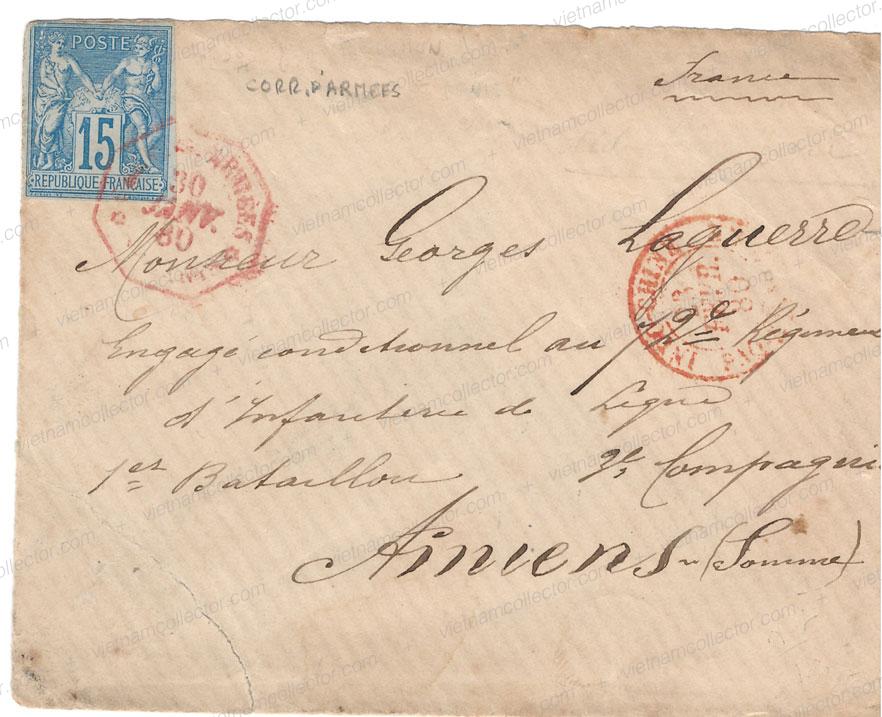
Single franking of the imperforate 15C Alpha Dubois stamp on a military letter sent from Saigon to France in January of 1880. Illegible fragment of the red Paquebot cancel. Indian transit and various French arrival cancels on the reverse.
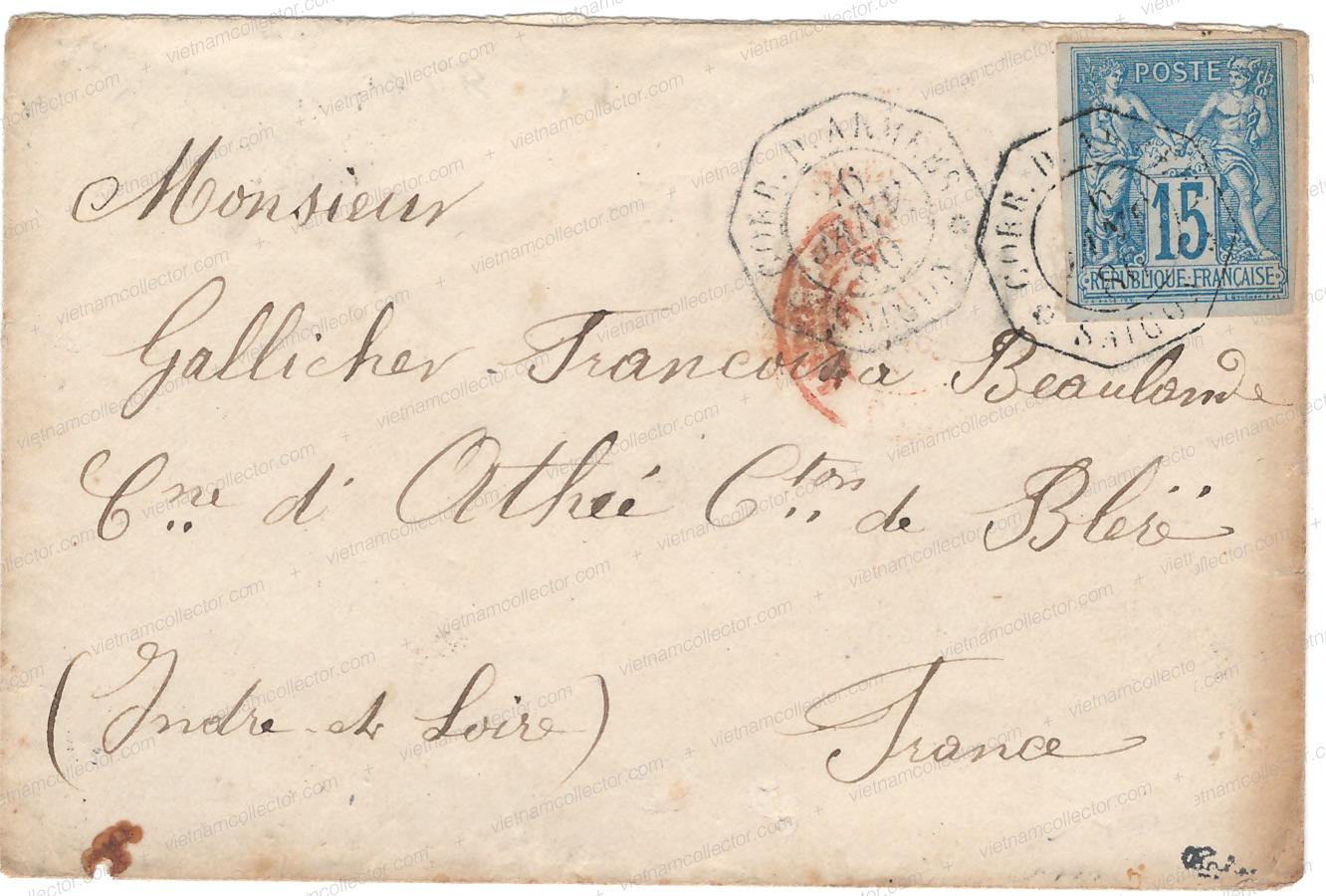
Postal stationary (11.5cmx7.6cm) of the 15C Alphee Dubois series for cancelled with the Saigon Central Post Office.
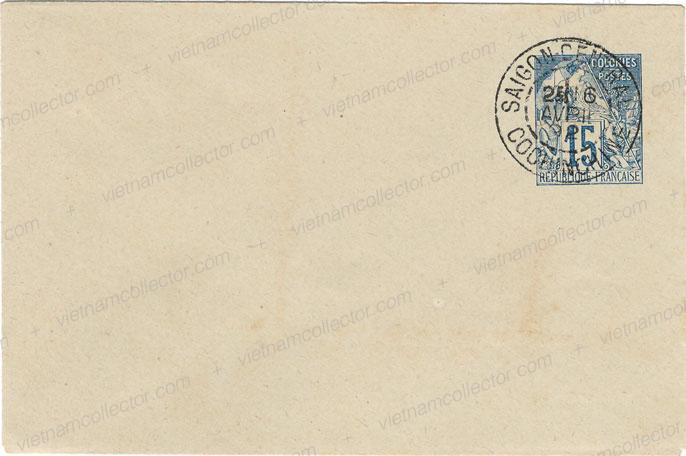
Postal stationary imprinted with the 15C Alpha Dubois stamp on a a domestic letter sent in September of 1990 from Hanoi to Saigon.
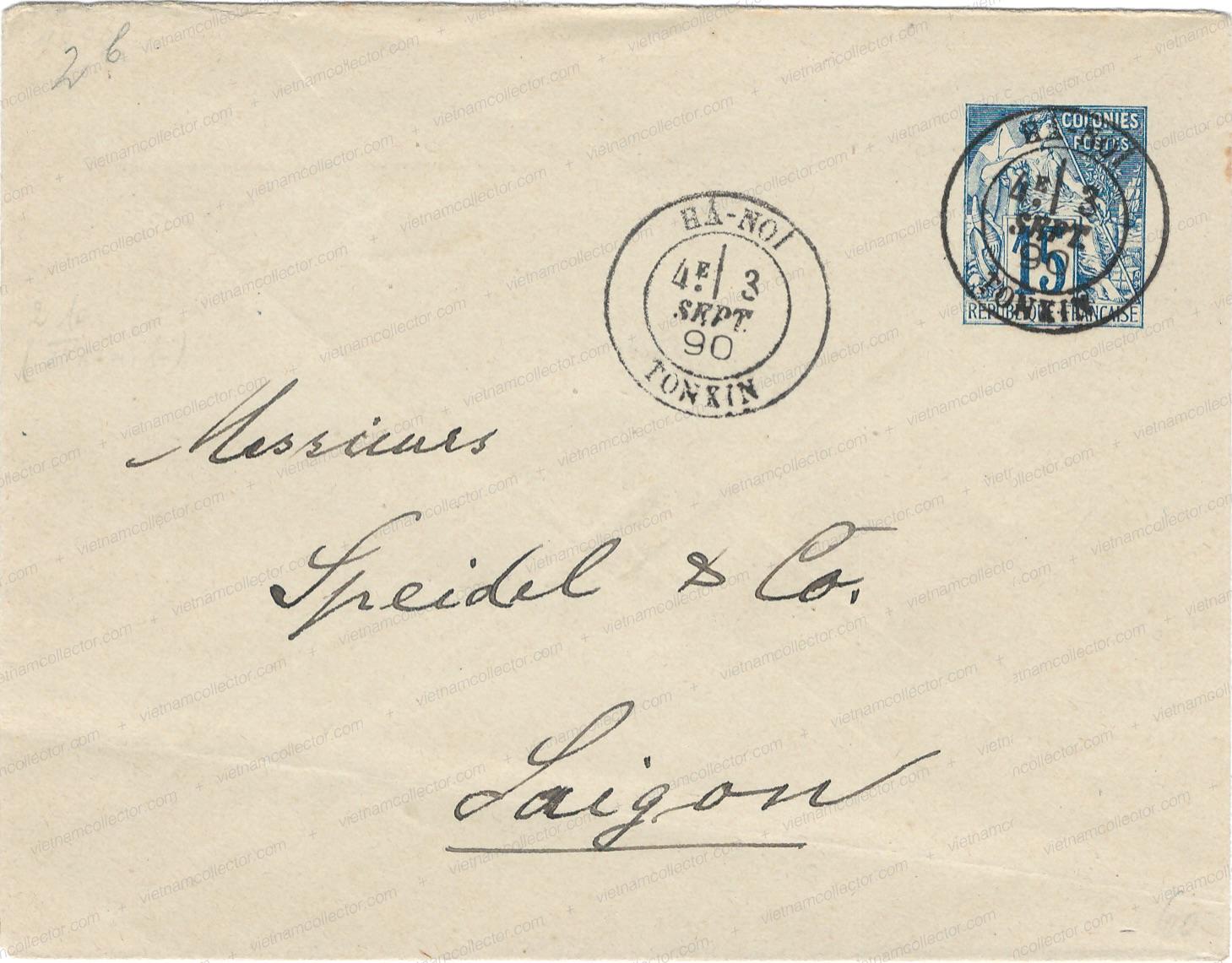
Postal stationary (14.5cmx11.4cm) of the 15C Alphee Dubois series for cancelled with the Saigon Central Post Office.
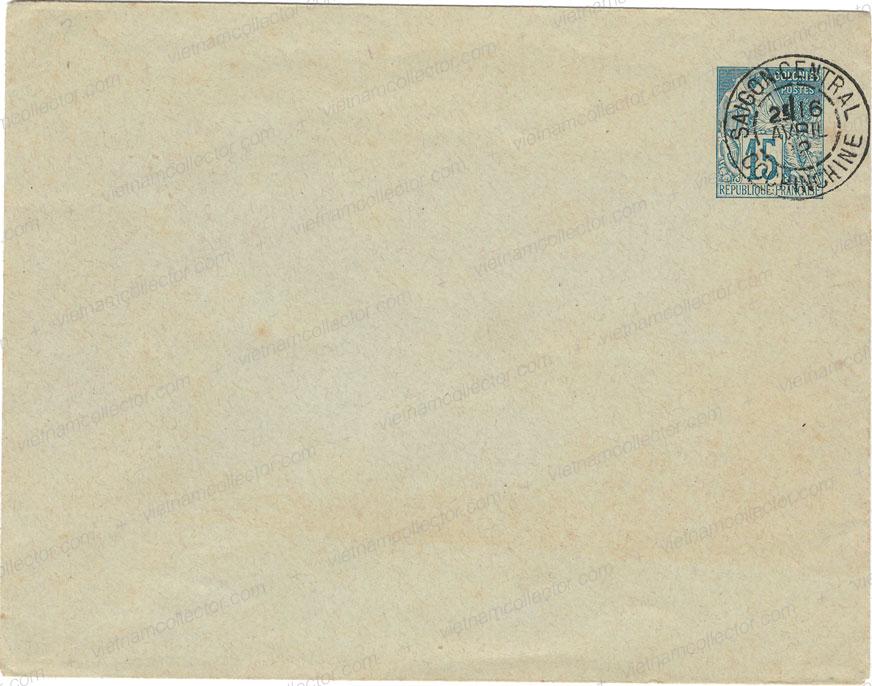
Single franking of the black 25C Alphee Dubois stamp on an international sent from Saigon to VIllecomtal, France in May of 1890. Villecomtal and Aveyron arrival cancels on the reverse.
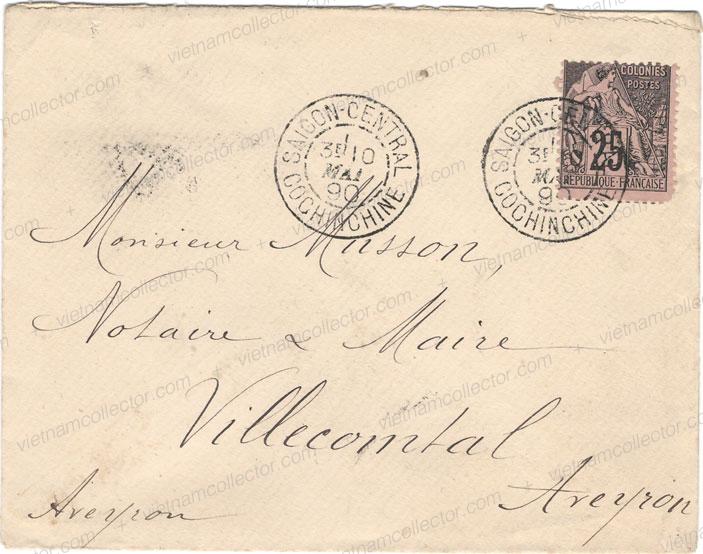 Multiple franking of the black 25C Alphee Dubois stamp (2) paying an overall postage of 50C on a rare registered international letter sent from Hanoi to France in November of 1889. Cancelled with the “Hanoi-Tonkin” circular double ring date canceler (Desrousseaux B 1). Boxed red “R” on front. Hai-Phong transit and French arrival cancels on the reverse.
Multiple franking of the black 25C Alphee Dubois stamp (2) paying an overall postage of 50C on a rare registered international letter sent from Hanoi to France in November of 1889. Cancelled with the “Hanoi-Tonkin” circular double ring date canceler (Desrousseaux B 1). Boxed red “R” on front. Hai-Phong transit and French arrival cancels on the reverse.
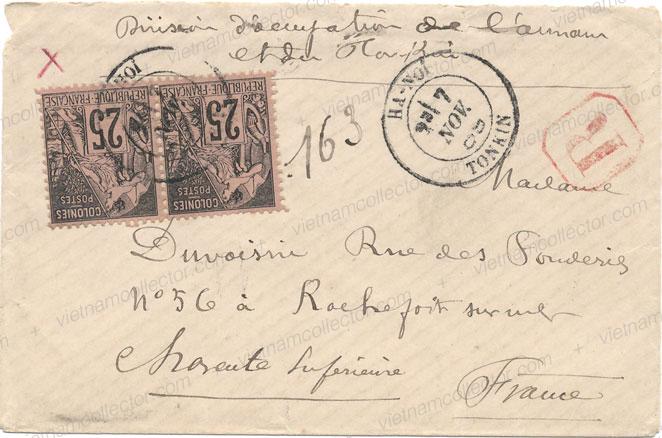
Single franking of the yellowish-brown 25C Alphee Dubois stamp on an international letter front sent in 1886 from Saigon to Paris, France. Cancelled with the circular “Saigon-Cochinchine” date canceler (Desrousseaux B 2).
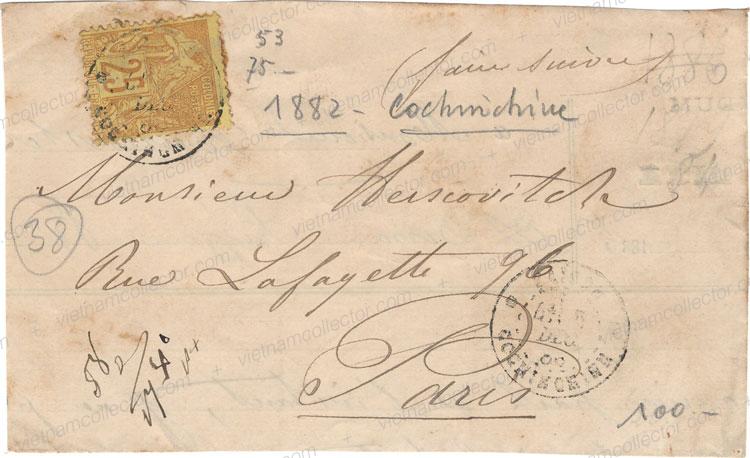 Registration Nr. 090000
Registration Nr. 090000

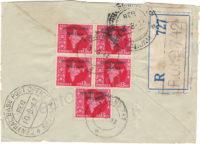
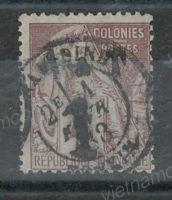
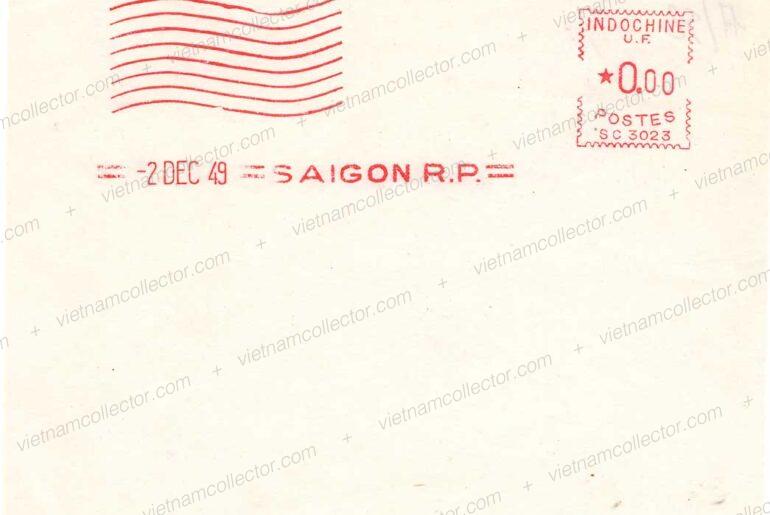
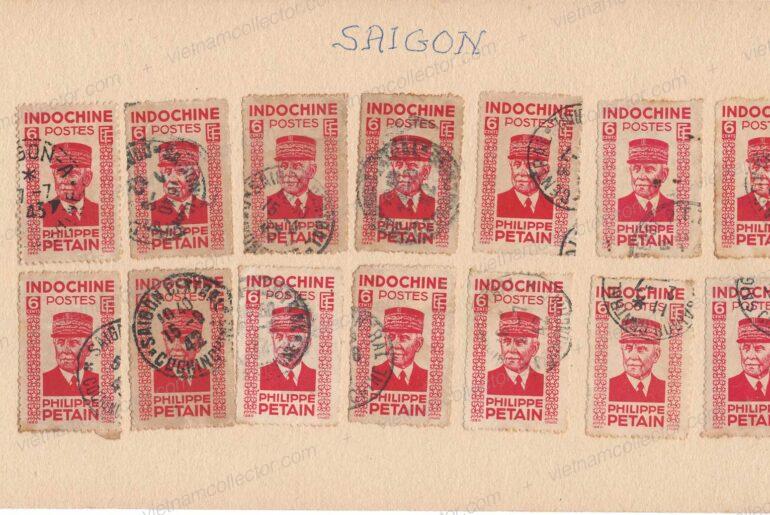
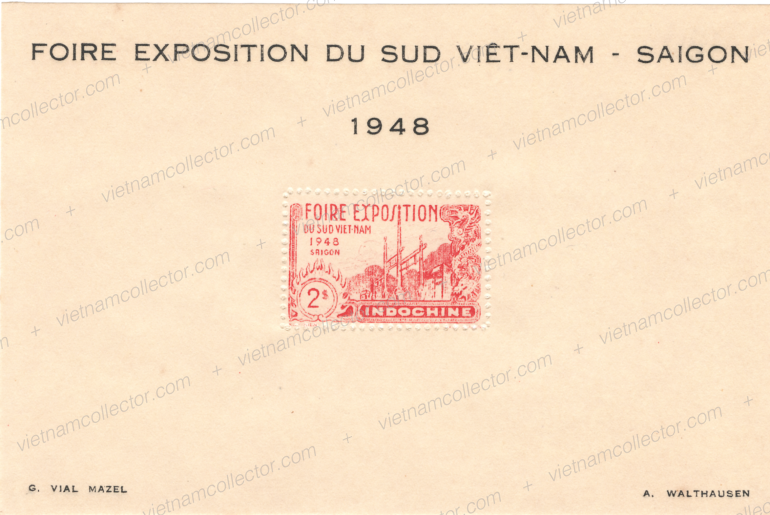
Comments are closed.